Benson class Destroyers (1939-41)
 US Navy Fleet Destroyers (1938-70s) – 30 destroyers: Benson, Mayo, Madison, Lansdale, Hilary P. Jones, Charles F. Hughes, Laffey, Woodworth, Farenholt, Bailey, Bancroft, Barton, Boyle, Champlin, Meade, Murphy, Parker, Caldwell, Coghlan, Frazier, Gansevoort, Gillespie, Hobby, Kalk, Kendrick, Laub, MacKenzie, McLanahan, Nields, Ordronaux
US Navy Fleet Destroyers (1938-70s) – 30 destroyers: Benson, Mayo, Madison, Lansdale, Hilary P. Jones, Charles F. Hughes, Laffey, Woodworth, Farenholt, Bailey, Bancroft, Barton, Boyle, Champlin, Meade, Murphy, Parker, Caldwell, Coghlan, Frazier, Gansevoort, Gillespie, Hobby, Kalk, Kendrick, Laub, MacKenzie, McLanahan, Nields, Ordronaux
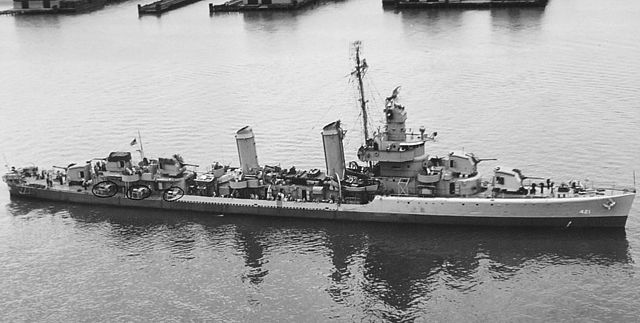
USS Benson (DD-421) as completed.
The Benson class were the last USN destroyers designed and built on a prewar design. This basic design was ready in 1938 and their keels laid down; The very first, USS Benson, which gave her name to the whole serie, launched in November 1939, just a month and 11 days after the invasion of Poland. The Bensons were closely derived from the Sims, but with a new boiler arrangement and two funnels, and the first to adopt quintuple torpedo banks. Repeat Bensons were ordered in addition from 1940 and the near-identical Gleaves class built in parallel. Overall, they mostly served in the Atlantic, with a few in the Pacific where they were either lost of gaining most battle stars for the class, some 170 in all. They were scrapped after a long reserve in the 1970s with two in service postwar with the ROCs and one with Italy.
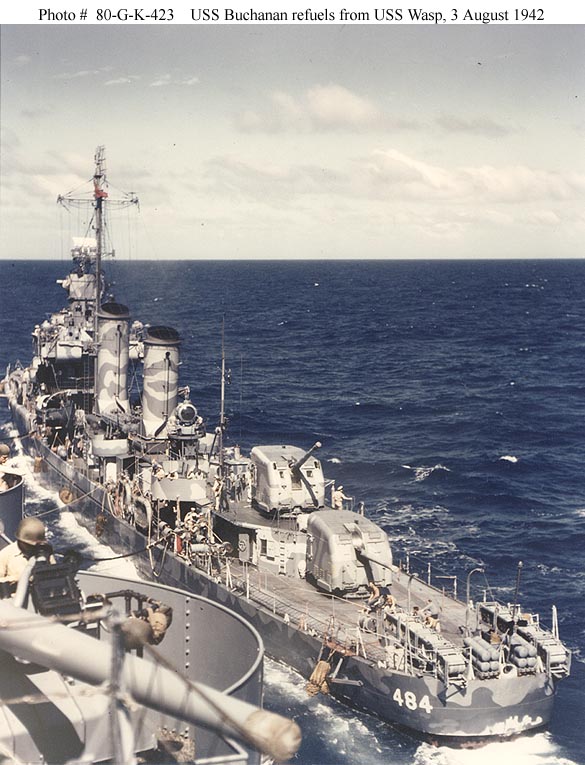
Nice aft view of USS Benson refuelling in late 1942, color photo at navsource
Design of the class
Although officially still 1,620 tons destroyers, the Benson class was far heavier, reaching 1,840 tons standard and up to 2,395 tons fully loaded. This made little difference as the Washington treaty was abrogated in September 1939. USS Benson was built in Bethlehem, Quincy, and Gleaves (DD 423, 9 December 1939) at Bath Iron Works. Other yards joined in the effort, Puget Sound, Federal -Kearny, Boston NyD, Charleston NyD, Seattle-Tacoma, and later Staten I yard, freshly built at Bethlehem and another at San Francisco, and San Pedro.
The Bensons were 24 ships as initially planned, with a first preserie of eight FY1938 so this was well before the war started. Of these, six were designed by Bethlehem Shipbuilding, to be built at Fore River and several government yards mandated by Congress. The last two of this preserie were to be designed by famous New York studio Gibbs & Cox, and built at Bath Iron Works.
In common, all were fitted with the new 600 psi (4,100 kPa) steam superheated to 750 °F (399 °C) boilers coupled with cruising turbines with the usual double-reduction gears for fuel efficiency as maintaining range was still paramount. Bethlehem once contracted requested design modifications, to use less-complex single-reduction gears, no cruising turbines arguing they could achieve comparable fuel efficiency due to the initially planned and more complex (and costier) machinery, and this request was granted. FY39 and FY40 destroyers built at Livermore Yard were of the earlier planned machinery. Many authors thus still call them the Benson-Livermore class.
By the spring of 1938 the Bureau of Steam Engineering requested both FY39 and FY40 ships to be fitted with the latest, more efficient 850 °F (454 °C) superheated steam boilers. Bath declined to built two FY38 ships (USS Gleaves and Niblack) and so the Gleaves was completed prior to Livermore, with a lower hull number, and did not succeeded to the Bensons. Many authors still also mentioned the “Benson-Gleaves class” due to these engines changes.
The external difference resided in flat-sided (Benson) or round (Gleaves) funnel.
With the war raging in Europe and 1940 battle of Britain it was decided to ramp up production of this new clas, whereas the new Fletcher class was work out, the first no longer treaty-bound. Existing facilities however could not be adapted right away to the much larger Fletcher-class so an additional 72 “repeat Benson-Gleaves” was ordered FY41. 24 repeat Bensons in all went from Bethlehem yards, 48 “repeat” by various other builders, including the sub class “Bristol”, the first of the “repeat Gleaves” completed. They differed by a machinery and had a reduced torpedo and gun armament for increased anti-submarine and anti-aircraft armament (motly Brownings and 20 mm Oerlikon guns).
Budget FY41, established on 1 July 1940 called for 8 destroyers, originally from DD-445 to be Fletchers but since the issues related above, eight Gleaves-class were ordered instead.
So that’s why a prewar design was produced to such numbers. Needless to say they arrived just on time for the battle of the Pacific (see later).
Construction
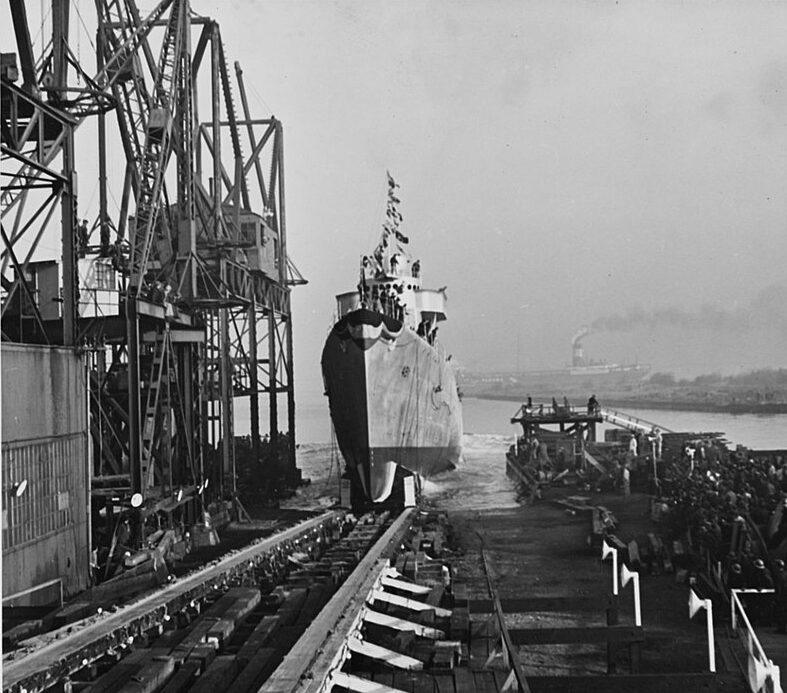
USS Farenholt being launched at Bethlehem steel Yard, Staten Island, NyC. on 19 November 1941. Pearl Harbor was not long away
The first six were authorized in fiscal year 1938 and laid down at Bethlehem Steel, Quincy, Massachusetts and three navy yards. The remaining 24 “repeat Bensons” were authorized in 1941–42 and built at four Bethlehem Steel yards. They were laid down after the first group was commissioned. These plus the “repeat Livermores” were also known at the time as the Bristol class.
The Benson class were built in 1939–1943, thirty 1,620-ton vessels in two groups: The first six were authorized FY 1938, laid down at Bethlehem Steel, Quincy, Massachusetts and three other naval shipyards. The remaining 24 were essentially emergency “repeat Bensons” authorized in 1940–42, built at the four Bethlehem Steel yards which were massively scaled up for the purpose. Laid down after the first group was commissioned they saw a few improvements, and were distinguished by a sub-class known as the “repeat Livermores” (or “repeat Gleaveses”) later renamed by authors for more clarity the Bristol class.
Bensons-Livermores (Gleaves class) or Benson-Livermore class persisted in references until the 1960s. Now most authors separates them, if not called “benson-gleaves” or simply the “benson class” and considering the remainder, Gleaves, Livermore and Bristols as sub-classes based on the minimal changes between them.
Essentially they became the first mass-produced USN destroyer class of WW2, stretching far too long in construction. In between the new Fletcher class, first true wartime design got rid of all limitations and went straight to maximum, ideal capabilities asked for the Navies.
Hull and general design
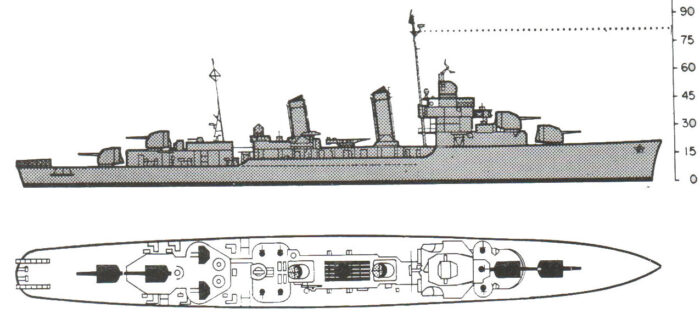
ONI schematics of the Bensons as modified with the extra AA in late 1942. Note the absence of the aft TT bank and extra intermediate 5-in gun.
The Benson class was still essentially a prewar design, but lessons had been digested so far: It was tried to negate stability issues and in the end, the Bensons became a improved version of the Sims class. Machinery wise, the difference produced a two stacks profile (squared in Bensons) with the “echeloned” machinery arrangement (alternated boiler and engine rooms) for torpedo survival. This was the first time this measure was taken. Until then, it was a secondary preoccupation. Gibbs and Cox was intrumental in that, showing that even with a Loss of one or even two adjacent compartments, the propulsion system was partly spare and the ship able to extract from danger, albeit at half-speed.
Displacement varied between series:
The DD421, 422, and 425-428 reached 1,911 tonnes standard for 2,591 tonnes fully loaded, whereas the DD423, 424, 429-444 were lighter at 1,838 tonnes standard for 2,572 tonnes fully loaded.

Complete overhead view with all details (click for full scale) for the early serie in its initial state by 1940. All images are renditions from World of Warships.
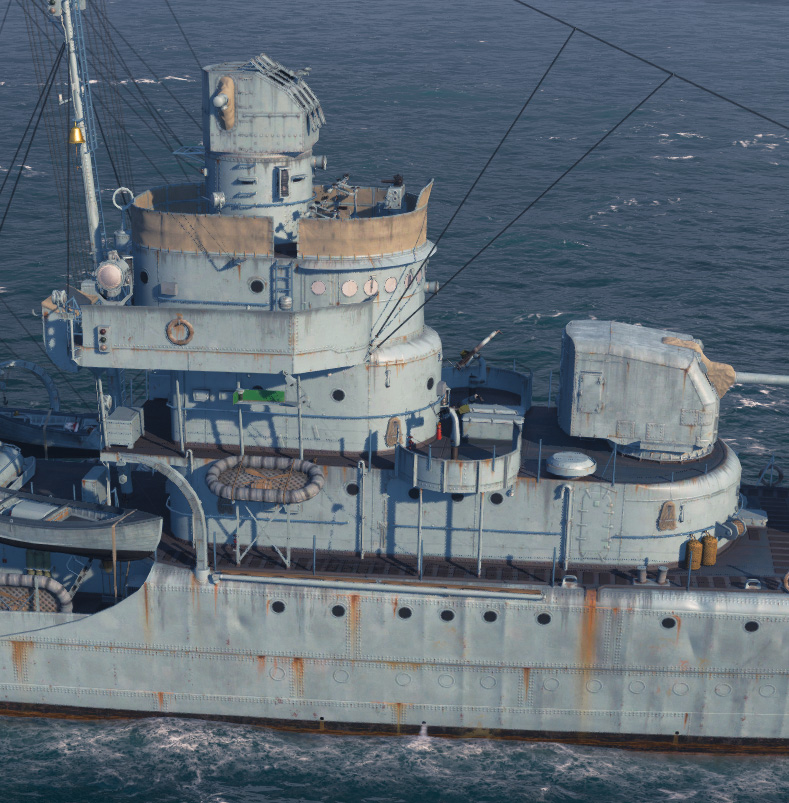
Forward detail for the bridge, flat-sided funnels, mast, fire control system, “B” superfiring gun, and the two initial cal.50 AA liquid cooled Navy Heavy Machine guns in their platforms. Later 20 mm Oerlikon replaced them. Note also the morse/signal projectors aft of the bridge’s wings.
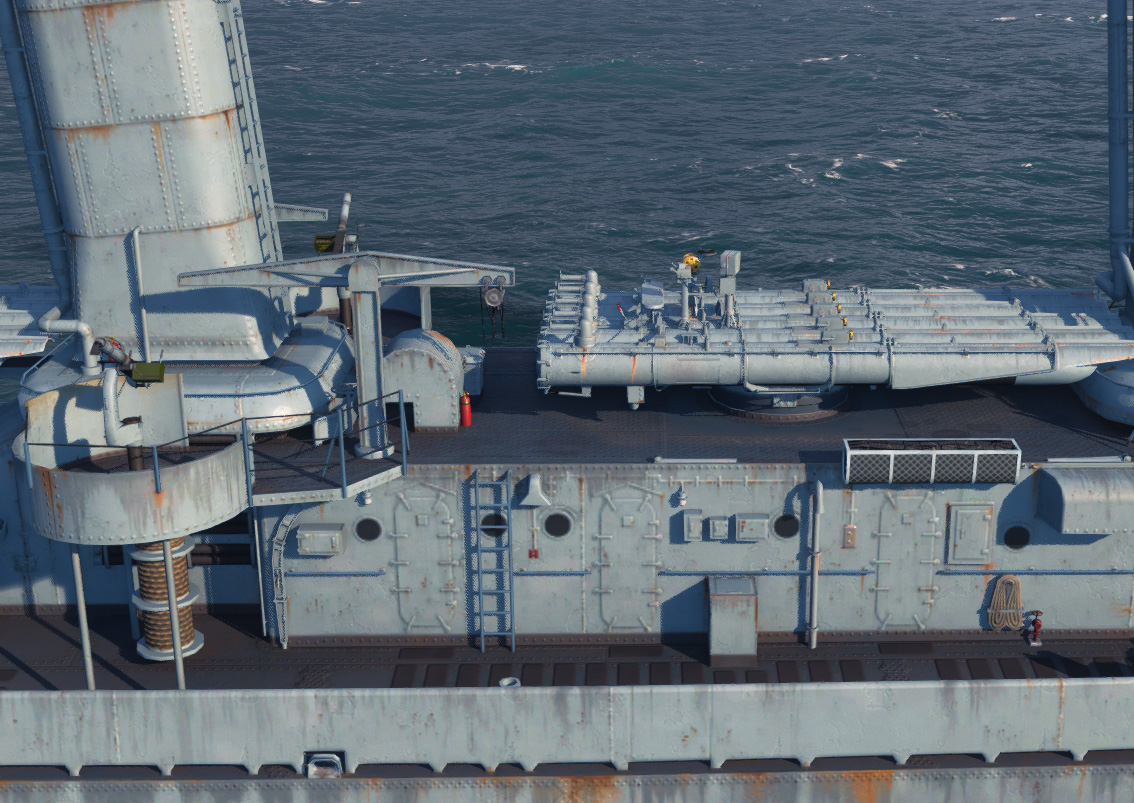
Details of the intermediate torpedo tubes bank and the reload apparatus at the foot of the aft funnel, encased winch and crane. The two amidship cal.50 AA are also visible.
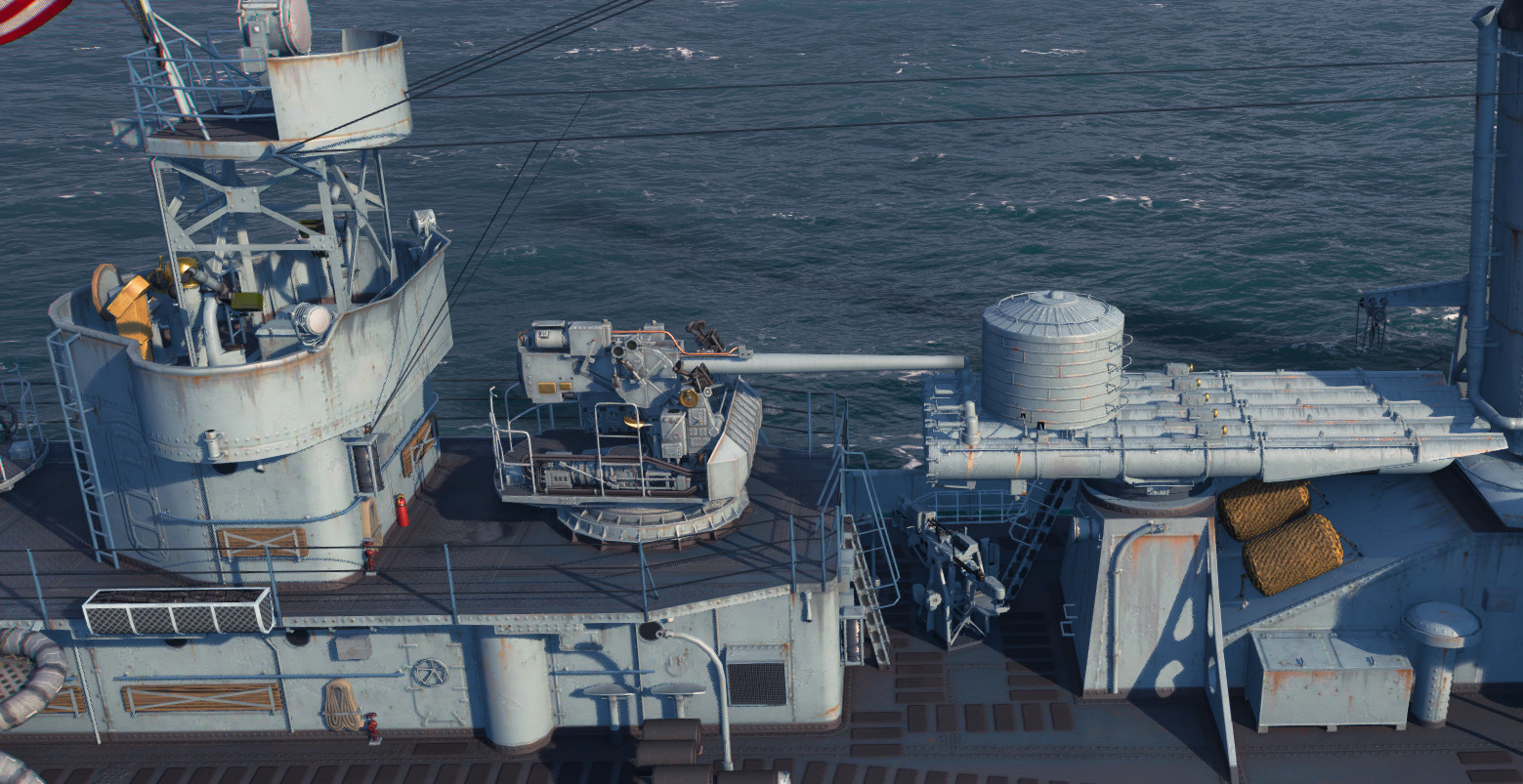
Aft detail showing the aft torpedo tubes bank (with the seated operator cylindric protection shield mounted), secondary reload system, “C” open gun mount, later both sacrificed for 40 mm mounts, and aftermost platforms for the last pair of cal.50 AA HMGs. The small lattice platform over the quarterdeck hour supports the main projector.
They were also the first to feature only two axial, but single quintuple torpedo tube mounts. Construction-wise, they had more extensive scantlings (framing dimensions) to better support the hull’s moves at sea while carrying the weight of a new, a bit heavier machinery. They also had more fuller hull lines, meaning a bit more drag but also more buoyancy, improving stability. The central section aft of the forecastle was straight up to second TT bank position, then slightly curved towwards the stern in a gradual ellipse. The rounded poop had the same extensions or “bull bars” anti-collision. They had the same counterkeels as previous destroyers to reduce roll.
Over the Sims this meant sixty tons more, so 1,620 tons standard. This was still very reasonable compared to the following Fletchers (2,050 tons standard). At 2,474 tons full load it was still reasonable and measures has been taken for oil bunkerage in the hull in order to avoid any imbalance.
The hull measured 341 ft (103.9 m) waterline, and 348 ft 2 in (106.12 m) overall, so a tad shorter than the Sims at 348 ft 3 in (106.15 m) for a similar beam of 36 ft 1 in (11.00 m) and an equal draft, ranging between 11 ft 9 in (3.58 m) at normal displacement and 17 ft 9 in (5.41 m) full load. The average on the Sims was 13 ft 4 in (4.06 m).
The bridge was simply the same as the Sims class, streamlined, something that was new at the time. Some older captains accustimed to the Farraguts and following ships’ glasshouse did not liked the new portholes, but the structure seems far less vulnerable. Plus when they needed to have a binocular look, the wings were enough for this.
The rest was a repeat of the Sims, with a continuous superstructure aft, superfiring guns fore and aft, this time only five, and two raised quintuple TTs, another big difference with the two funnels. The Bensons had a single fire control system on top of the bridge, and two masts, a pole foremast attached to the back of the bridge to support light radars (added later) and hoist flags. The small mainmast aft was located just in front of the third main gun. During the war it was fitted with a radio detector, “Huff-Duff” type. Over time, changes were made to add more AA/ASW assets (see later). As usual the forecastle was completed by long bulwarks running all the way to the mainmast aft as heavy weather guards.
Powerplant
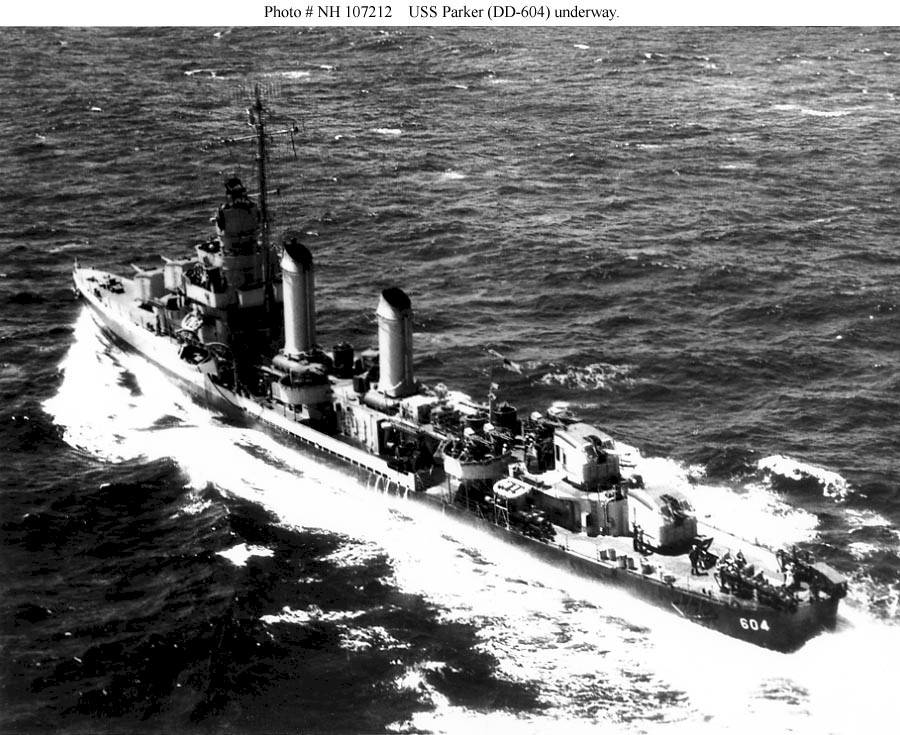
USS Parker after her last refit trials off New York, prepared to join the Pacific.
All these ships were to share the same proven high pressure-high temperature propulsion machinery from the Mahan class. However Bethlehem (Which had no experience with this type of machinery) asked for design changes and a simpler type that it clailed would prove equally efficient. The Bureau of Engineering at first expressed its opposition to what they called a “bastard design” and because of a possible unacceptable delay. FY 1938 ships (DD 421–428) were six built to the Bethlehem (Benson) design, two (DD 423–424) to the Gibbs & Cox (Gleaves) design.
The Bureau requested a design change to increase to 825° boilers for repeats (Gleaves) designed by Gibbs & Cox, and these were called the Livermore class (DD 429). Bath Iron Works meanwhile also incorporated this change in the first two ships and so the Gibbs & Cox-designed destroyers are now called the Gleaves class: FY1939 FY1940 ships were DDs 429–444. Bethlehem’s repeat Bensons however, sticking with its own machinery were denied construction.
The Bensons were given the new “M”-type boilers rated for 600 psi (4,100 kPa) steam and superheated to 750 °F (399 °C). They were using single-reduction gearing, no cruising turbines as suggested by Bethlehem Steel. The latter designed in-house and produced these main steam turbines. The repeat-Bensons had new boilers rated for 850 °F (454 °C) however, but they were only used on the later ships of the serie. These models were also fitted on the Fletchers. The latter serie (non-Bethlehem Yards) opted for the standard of two sets Westinghouse geared steam turbines, and the same four Babcock & Wilcox boilers.
Thus the standard Installed power (Bethlehem ships) comprised to shafts with 3-bladed propellers connected to shafts, driven by two Bethlehem Steel geared steam turbines without reduction (simpler and lighter) and fed in turn by four standard double-ended Babcock & Wilcox boilers, superheated for a grand total of 50,000 shp (37,000 kW).
This enabled a comfortable top speed of 37.5 knots (69.5 km/h) light load on sea trials (even more) down to 33 knots (61.1 km/h) full load in combat.
Thanks to the lighter, compact machinery (still heavier than previous arrangements), Range could be maintained to a reasonable 6,500 nautical miles (12,000 km; 7,500 mi) at the cruise speed of 12 knots (22 km/h; 14 mph). On this topic, the bulk capacity was augmented on the “repeat Bensons”, and so oil could vay from 302 to 453 tonnes, for a 3,630 to 3,880 nautical miles at 20 knots.
Armament
pic
The original armament was five 5-in/38 (127 mm) Mk 12 enclosed gun mounts, two forward in superfiring pair, two aft, same, with an intermediate mount facing forward on the same aft quarterdeck house as the N°4 gun. Both this N°3 and N°4 had not shielding (open mounts). Later in the war, the N°3 was most often landed and the N°4 was swapped for an enclosed mount.
This was completed by six cal.05 Browning M1920 heavy machine gun (12.7mm/90) in twin positions, three total. Of course this was completed by two quintuple 21-in (533mm TT) banks, and 14 spare torpedoes, plus two DCR (depht charge racks) aft, for 10 charges total.
This was not a revolutionary choice, apart for one item: The torpedo tubes banks. Two centerline quintuple torpedo tube mounts became soon the norm, allowing the same broadside of ten while saving space and weight, unlike the three to four banks solution. The admiralty however did not renounced to have five of the rather excellent 5-in/38 DP gun. Four for this tonnage seems more reasonable when trying to fit extra AA without compromising stability.
Main
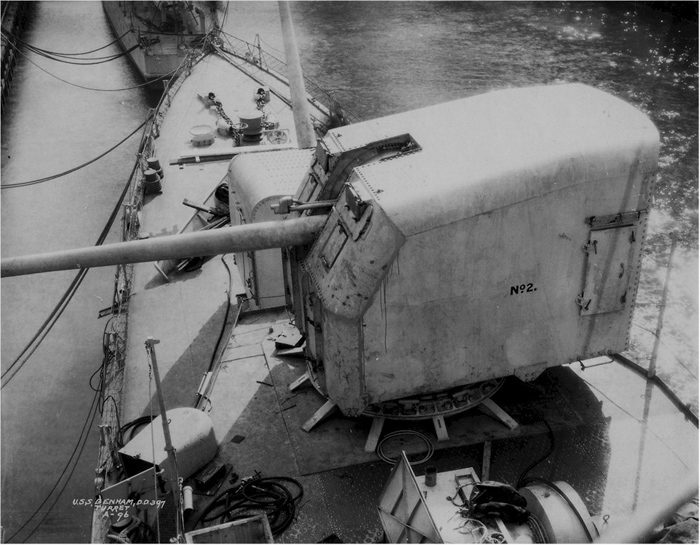
5-in/38 enclosed mount on USS Benham.
The class was completed with four or five 5-inch (127 mm) dual purpose guns (anti-surface and anti-aircraft (AA)), controlled by a Mark 37 Gun Fire Control System as in the previous Sims class.
This was a powerful armament, well completed by ten torpedo tubes.
⚙ 5-in/38 Mark 12 specifications |
|
| Open Mount full weight | Mark 30 mount Mod 1: 33,500 lbs. (15,195 kg) |
| Enclosed Mount full weight | Mark 30 mounts Mod 41: 41,400 lbs. (18,779 kg) |
| Barrel | 3,990 lbs. (1,810 kg) without breech, 223.8 in (5.683 m) long |
| Muzzle Velocity | 2,500 fps (762 mps) average |
| Rate of Fire | 15-22 rounds/minute |
| Elevation | -10 to +85° |
| Range | Max 85°, 2,940 yards (2,688 m) |
| Crew | 8 inside, 7 outside open src |
| Ammunition | Bensons: 320 (Gleaves 360) |
| Penetrating power | 13,800 yards (12,620 m): 1.0″ (25 mm) armor* |
*with special common shell
Torpedo Tubes
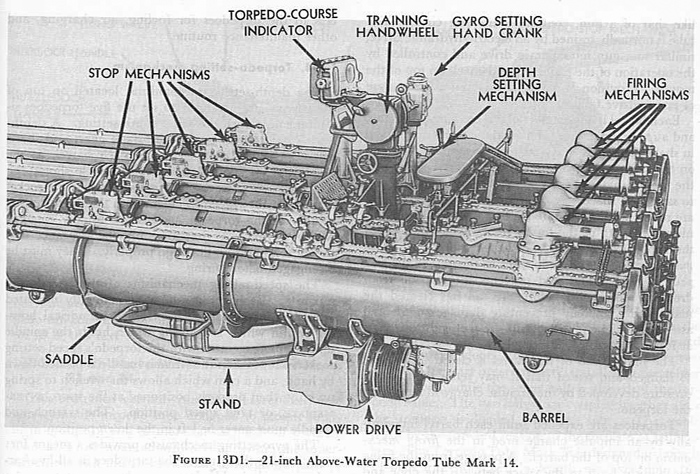
ONI explanation on the Mark 14 Quintuple Bank of the Benson-Gleaves (from navweaps).
The adoption of quintuple banks, the norm on the USN until heavy torpedoes were dropped altogether in the 1960s, was the fruit of numerous critics about the aside arrangement of banks (On all DDs since the Farraguts, as they were reported to be regularly hammered by waves, conducting to failured, deformations and heavy corrosion. Thus on FY1939 program destroyers built by FY1938 design the admirakty decided to rearrange all torpedo tubes to centreline, and raised well above the deck by a full structure, out of harm of sea spray. This also enabled place for spare torpedoes. The tradeoff put an end to the old trope of “scissors fire” or curve-ahead fire enabled by using a setting for the side banks. The admiralty wanted to preseve firepower and was assured by the Bureau of Ordnance that it was possible to mount a fifth tube on the regular, but upsized bank in use until then.
This for the first time, a US destroyer (any destroyer in the world for that matter) earned a quintuple torpedo tube bank. While the European norm was two triple, or two quad bank, a broadside of ten torpedoes was the greates ever achieved by any destroyer in service at the time. The Japanese typically had three triple banks, but that went for nine torpedo broadside, however the reload system was faster. The 14 reloads (or 10 dependong on sources) were stored close to the banks, and it was a manual (still helped by a crane and winches) and risky, long operation requiring a calm sea state. It was assumed that once the broadside was spent, the ship was down to its artillery for the remainder of the fight.
There were concerns about such a large torpedo salvo, but the successive launch allowed to alleviate wake interferences. Bureaucratic delays had however the number of spare torpedoes under specification limited to four, so the ship had on paper just 14 including the ones already loaded, or just ten, so no reloads at all. See a color rendition of the mount.
The MK 14 and MK 15 torpedo tube mounts were both capable of launching the 21-inch MK 15 torpedo. The trainable, quintuple arrangement was derived from the quadruple one with a larger base. Each mount comprises a stand, saddle, barrels, controls, heating equipment, and the caracteristic rounded blast shield on the MK 15 mount only. The latter was was installed to protect the crew from nearby 5-inch gun blast but the rest was were identical between the two Marks. Stand and saddle were equivalent of a base ring/carriage for a standard gun mount. The first was bolted to the deck, housing the training circle and bearings for the saddle.
The latter supported five barrels in a parallel arrangement, secured via hold down clips. Barrel assemblies comprised the main barrel, door and spoon extension bolted to the saddle via ring flanges. Doors aft (breech end) were hinged. Spoon extensions forward were also hinged, folding backwards on top of the barrel for better access to the torpedo warhead. Controls of the torpedo gyro and accesss to the depth and speed settings were fitted atop the barrels, aft of the ring flanges. They were electrically input. There were also two rows of barrel heaters underside close to the torpedo mechanisms as de-icing implement in cold weather.
The firing mechanism on top of each tube was located on aft end forward of the breech doors. They were launched individually by ignition of black powder from impulse cartridges that were to be replaced each time, fired either by hydraulic percussion or electrically. They were re-trigerred by a tripping latch after the torpedo left the muzzle.
Each Benson class ship has a pair of retractable loading cranes (one for each bank) and chain fall holding the torpedo to be aligned with the tube when reloaded, then manually pushed into the tube.
The while operation was too long and needed too pristine conditions to be carried out in the heat of battle.
⚙ Mark 14 Bank, 21-inch MK 15 Mod 3 torpedoes specs |
|
| Weight | 3,841 lbs. (1,742 kg) |
| Lenght | 24 ft (7.315 m) |
| Settings | 4,500 yds/45 kts – 9,000 yds/33.5 kts – 14,000 yds/26.5 kts |
| Propulsion | Wet-Heater steam turbine |
| Warhead | 801 lbs. (363 kg) TNT or 823 lbs. (373 kg) HBX |
| Exploder | Contact |
| Guidance | Mark 12 Mod 3 gyro |
| Reloads | Bensons: 0 to 4 |
Anti-Aircraft Armament
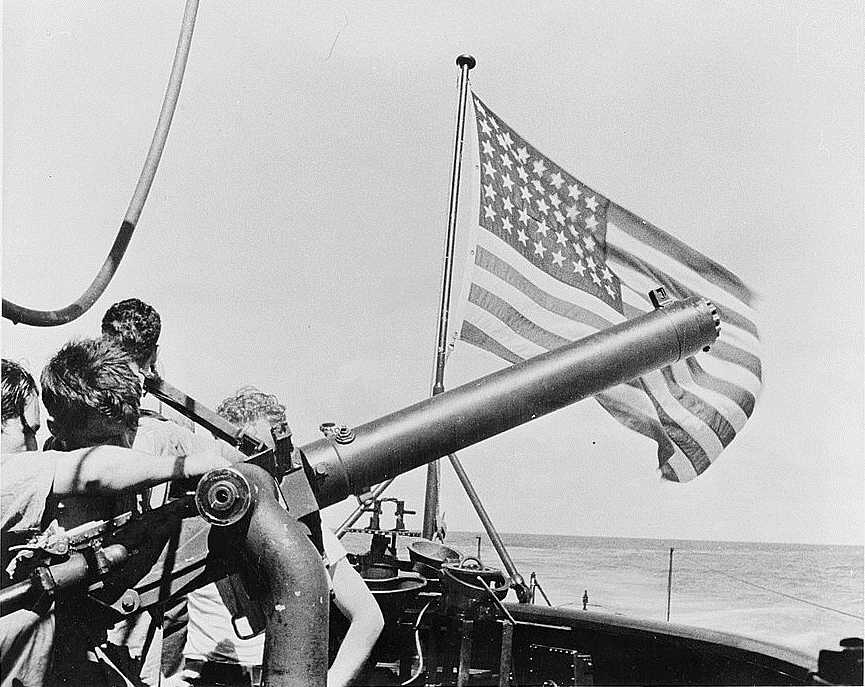
Single liquid-cooled HMG, navy standard in 1941 (navsource).
This varied over time but initially the Bensons had three pairs of liquid-colled M1920 Browning 12.7 mm Heavy Machine Guns (HMG). They were located on three pairs of platforms forward, amidships and aft. This was even less than previous ships (the Sims had eight). Soon however as the war started in December 1941, 20 mm guns were obtained as soon as available, traded for any Browning 0.5 cal. mount as a per-mount basis. The 0.5 cal. could fire 550 rounds per minute cyclic per barrel (so 1,100 per mount). It had a ceiling between 5,000 feet (1,524 m) and 15,000 feet (4,570 m).
More on navweaps
The admiralty came out with a scheme to mount 40 mm Bofors in twin mounts, which required to retire N°3 main gun. An later N°2 TT bank also. But these upgrades were halp-hazard due to bottlenecks in the production of the 40/56 Mk 1.2, which arrived each time the ships were refitted. This was always with twin mounts, but by 1945, extra space was found for a quad mount in addition.

The twin-barrel 40mm/55 Mark 1.2
More on the naval weapons encyclopedia
Before this and until late 1943 for some, a single 1.1-in quad (28mm/75) Mk 1 mount was retained, often installed in 1942. They were not appreciated, but available in large numbers. It’s only from early 1944 that these twin 40 mm arrived. They took the place of N°3 gun, so reducing main armament to four 5-in/38 Mk 12, but for two twin 40mm/56 Mk 1.2, and four single 20mm/70 Mk 4 in complement and all their 21-in torpedo tubes (as well as their ASW DCT, and DCR for up to 50 grenades).
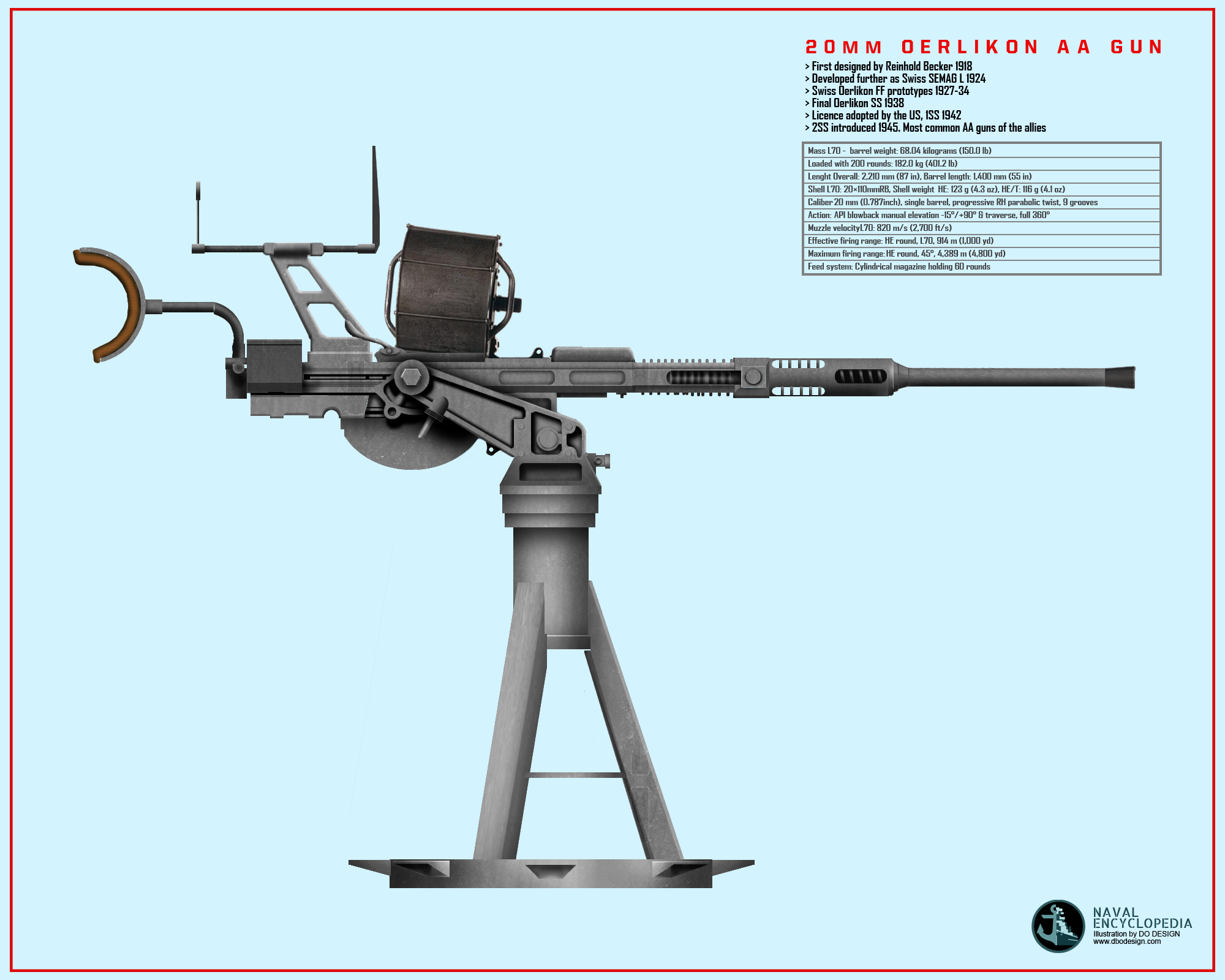
20 mm/70 Mark 4 single mount. These ships had at first those, then twin mounts. More.
Anti-Submarine Weaponry (ASW)
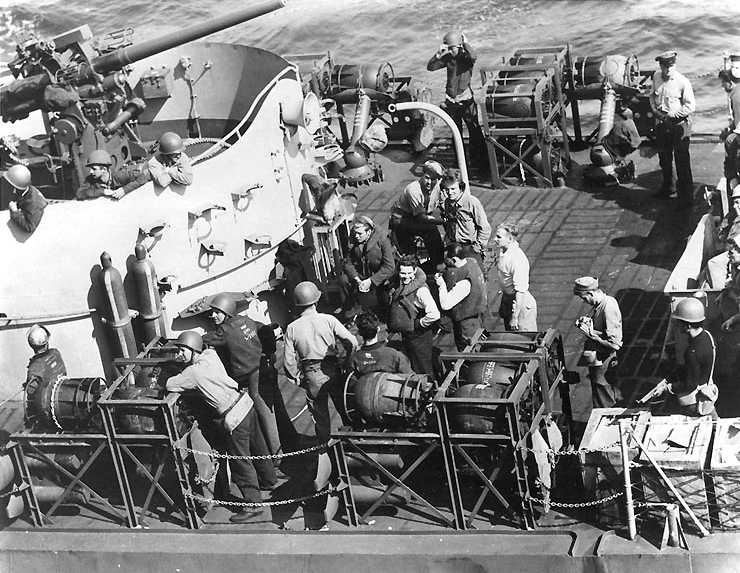
Y-Guns and crew (USS Inch, DE-146) with Mark 9 depht charges recoignisable to their teardrop shape ensuring quicker sink rate.
Pre-1942 destroyers had their original anti-submarine suite at the poop, two depth charge racks of the Mark 1 Mod 1 type (5 DC each), later augmented to four or six Mark 6 K-gun (depth charge throwers) in 1941–42 whereas the stern depht charges went to ten each (Mark 3). Any of the Y-guns was composed on a single launcher (thrower) and three ready reloads. If upgraded to the Mark 9 DC, the K-Gun was also a Mark 9.
The typical Benson’s depth charge could be either the following types:
–Mark 7 (1937, service 1938): 745 lbs. (338 kg) with 600 lbs. (272 kg) TNT warhead
Sink Rate or Terminal Velocity 9 fps (2.7 mps), set range from 50 to 300 feet (15-91 m)
–Mark 8 (1941, s. 1943)-Magnetic pistol DC.
525 lbs. (238 kg), 270 lbs. (122 kg) TNT warhead, sink Rate 11.5 fps (3.5 mps), up to 500 feet (unreliable but probably tested on Atlantic ships of the 1st serie)
–Mark 9 (1941, s. 1943): late war teardrop model with greater sink rate.
320 lb to 340 lbs. (154 kg) warhead 190-200 lbs. (86-91 kg) TNT
Sink rate 14.5 fps (4.4 mps) up to 22.7 fps (6.9 mps) for mod 2
Setting range from 50 to 600 feet (15-183 m). Standard for ships re-equipped in 1944-45.
Sensors & FCS
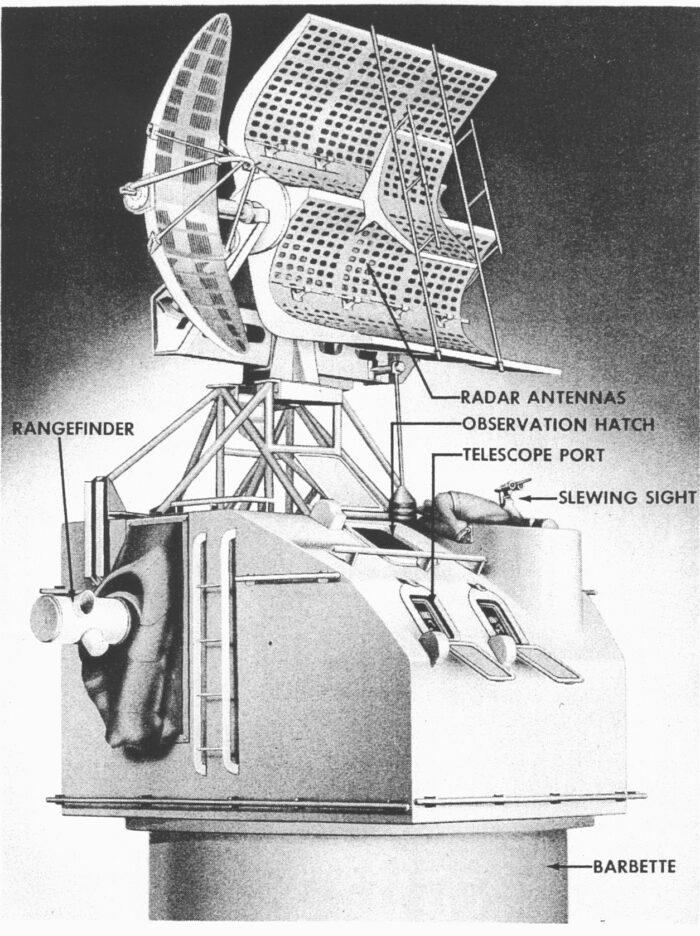
As completed, DD421 to 434 were given a QCE sonar in complement to their ASW additions. For the later “repeats” serie, DD435-444 presumably they were fitted with the SC, Mk 4 radars, and QCE sonar as standard.
Mk37 GFCS
The Ship gun fire-control system on top of the bridge is a classic, that replaced the older Mark 33 on all destroyers from the Farraguts and following. Fully enclosed, lighter, better protected and with a radar on top. It was completed by a computer Ford Mark 1. Rate information for height changes enabled complete solution for aircraft targets moving over 400 miles per hour (640 km/h). From the Sims onwards such computer was installed, naturally repeated on the Benson/Gleves, but upgrades were made in wartime to to make it compatible with the development of the VT (Variable Time) proximity fuze, dropping the timer or altitude system, way more efficient against aviation.
SC radar
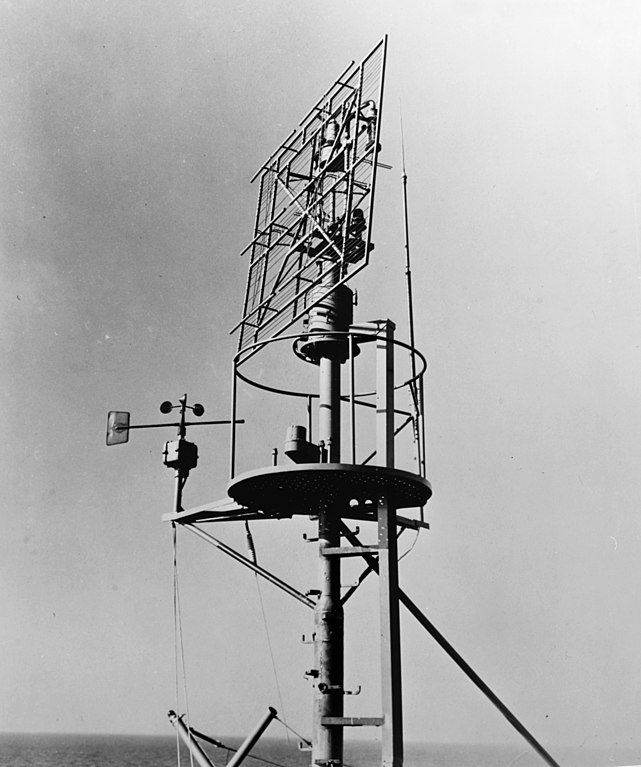
Introduced in 1942 this classic among classics 220 kW Air/Surface-search radar worked on VHF band:
PRF 60 Hz, Beamwidth 10–25°, Pulsewidth 4–5 μs, Range 48–120 km (30–75 mi), Precision 90–180 m (98–197 yd)
Mark IV FE FCS Radar
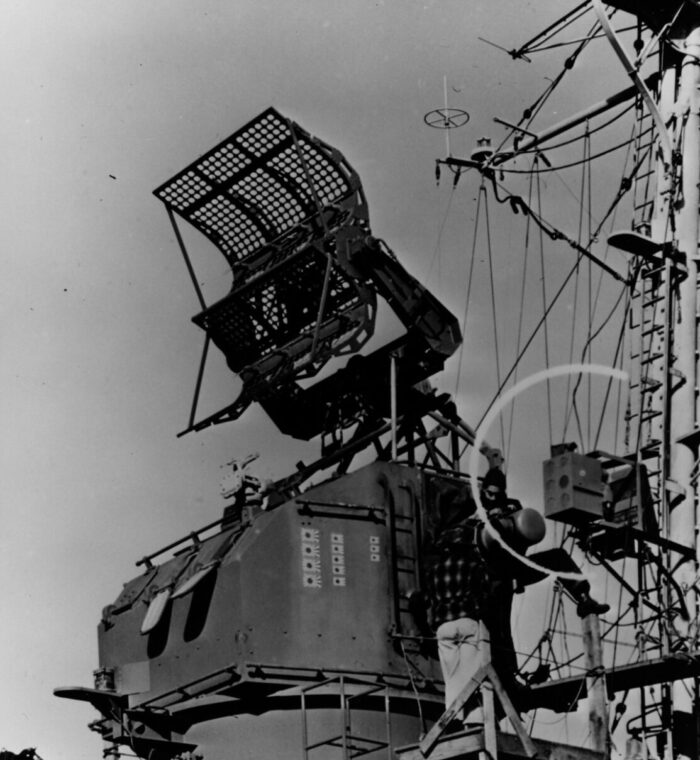
The Radar Mark 4 Or Type FD was mounted on top of the Mark 37 Fire Control System. Photo; USS McCalla, 5 January 1944. src Naval History and Heritage Command.
Specs:
Bearing Accuracy 0.225, Bearing Resolution 10, Horizontal Beamwidth 12, Vertical Beamwidth 12
Range Accuracy 37m, Range Resolution 365.76m, Range in Nautical Mile 19.966
Radar Antenna Siz 1.829 m
QC Sonar
The U.S. Naval Research Laboratory developed the first “QA” sonar, which was to become the first destroyer-mounted, echo-ranging sonar in the U.S. Navy, operating at 15 to 20 kHz. By 1933, the QA sonar was installed on eight destroyers. Subsequent improvements in transducer technology yielded the QC series, which was installed as a standard ASW active sonar on all U.S destroyers at the outbreak of World War II (Friedman, 1988). When two-letter designators were used for U.S. Navy equipment, the first letter indicated the type of equipment (Q represented Sonar Echo Ranging
Listening equipment) and the second letter indicated the subtype of the equipment. src and also and this.
Modifications
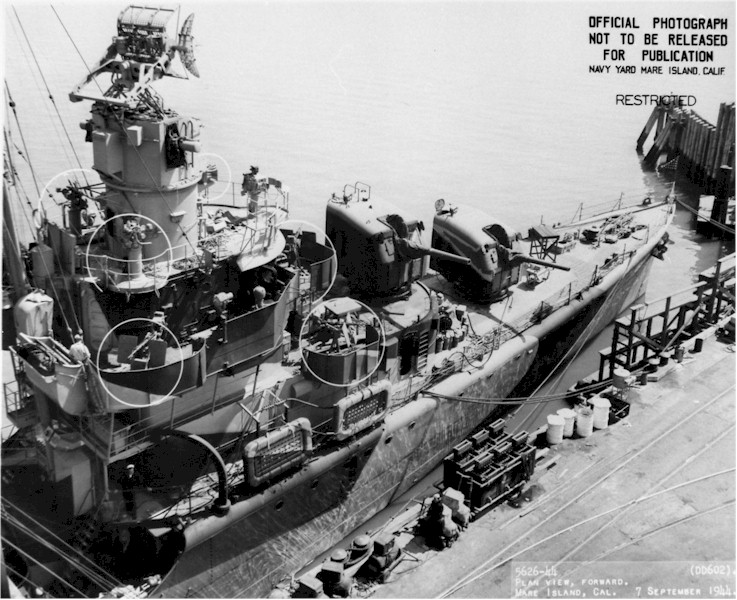
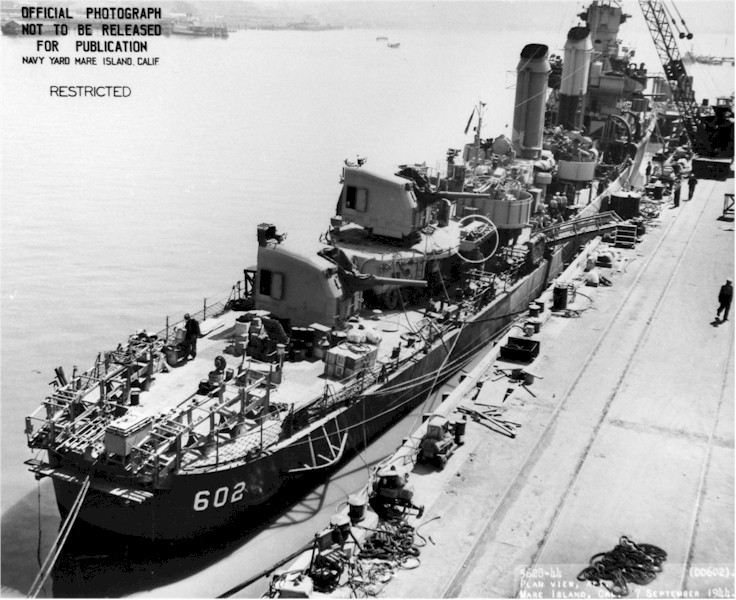
Overhaul of USS Meade DD-602 at Mare Island in July-September 1944.
The war soon showed the need for extra AA armament, and the only viable sacrifice was the aftermost quintuble bank. This most Bensons soldiered on with a single bank but heavier light anti-aircraft armament. All ships ended with various specifications, but the Navy still specified a pair of twin 40 mm (1.6 in) guns, which only arrived from mid-1942 whereas quad 1.1 in (28 mm) “chicago-piano” mounts were most often the norm, completed with single 20 mm (0.79 in) AA guns, temporarily.
In 1945 twelve of these vessels (DD-600-601, 603–604, 608, 610, and DD-612-617) reached their maximum preconised AA armament, to act as kamikaze killers: They had already their four 5-inch/38 guns this time with the latest fire control and fuses for maximal accuracy, no torpedo tubes at all, replaced by no less than twelve 40 mm guns: Two quad, two twin mounts, and a reliquate of light AA with four 20 mm guns, in two twin mounts for maximum deck space optimization. The first six of these already only had a single bank while in Atlantic service for more ASW depht charges and throwers, and when transferred to the Pacific had a 5-inch gun removed and regained a TT-bank.
In 1941 a single DCT (“Y”-gun) was added and the total of depht charges was ported to 22 as they were implicated in more agressive neutrality patrols.
By early 1942, all six cal.50 (12.7mm/90) Browning AA were removed as well as the second quintuple 533mm TT and the sold DCT (“Y”-gun), for the addition of six 20mm/70 Mk 4 AA (possibly as a one-per-gun basis for the Brownings) and four to six DCT (throwers) of a new semi-atuomatedmodel (total 44 to 50 depht charges)
For the remainder of 1942, some had their N°3 5-in/38 removed to installed a quad 28mm/75 Mk 1, and an extra single 20mm/70 Mk 4 AA gun.
Until 1944, almost all were installed new electronics, the SC, SG, Mk 4 or Mk 12.22 radars and/or SG radar.
Until late 1943, the quadruple 28mm/75 Mk 1 installed was removed to install another 20mm/70 Mk 4 and see the 127mm/38 return. In between fuses and accuracy made them very efficient AA guns.
In early 1944, however the standard was four 5-in/38 Mk 12, two twin 40mm/56 Mk 1.2, four single 20mm/70 Mk 4, both 21-in TT banks and 4 to 6 side DCTs as well as their poop DCR (up to 50 depth charges)
By March 1944, it is known that USS Benson, Mayo, Gleaves, Niblack, Madison, Lansdale, Hilary P. Jones, Charles F. Hughes, Livermore, Eberle, Plunkett, Kearny, Woolsey, Ludlow, Edison, Ericsson had only one TT bank, two single extra 40mm/56 Mk 1.2, and four extra 20mm/70 Mk 4 AA guns. Still it was flet not enough as the Kamikaze threat became evident.
In November 1944, USS Benson, Mayo, Gleaves, Niblack, Madison, Hilary P. Jones, Charles F. Hughes, Livermore, Eberle, Plunkett, Kearny, Woolsey, Ludlow, Edison, Ericsson saw the removal of these two single 40mm/56, four 20mm/70; and return of their second 21-in TT bank.
By the summer of 1945, USS Gleaves, Niblack, Livermore, Eberle, Plunkett, Kearny, Grayson, Woolsey, Ludlow, Edison, Ericsson, Swanson saw the removal of both TT banks and four 20 mm AA for a full “Kamikaze conversion”, with two quadruple 40mmm/56 Mk 1.2, and two twin 20mm/70 Mk 4.
By January 1946, at the time of the Japanese occupation, the remainder DD421, 422, 425, 427, 428, 441, and 442 had four 5-in/38 Mk 30 main guns, two twin 40mm/60 Mk 1, four single 20mm/70 Mk 10, both TT banks, 6 DCT, 2 DCR and as electronics were concerned, their SC, SG, Mk 4 or Mk 12.22 radars and QCE sonar.
DD423, 424, 429-432, 435, and 437 to 440, 443 (the “kamikaze conversion”) had their two quad 40mm/60 Mk 2, two twin 40mm/60 Mk 1, two twin 20mm/70 Mk 24, same ASW and same electronics.
Name
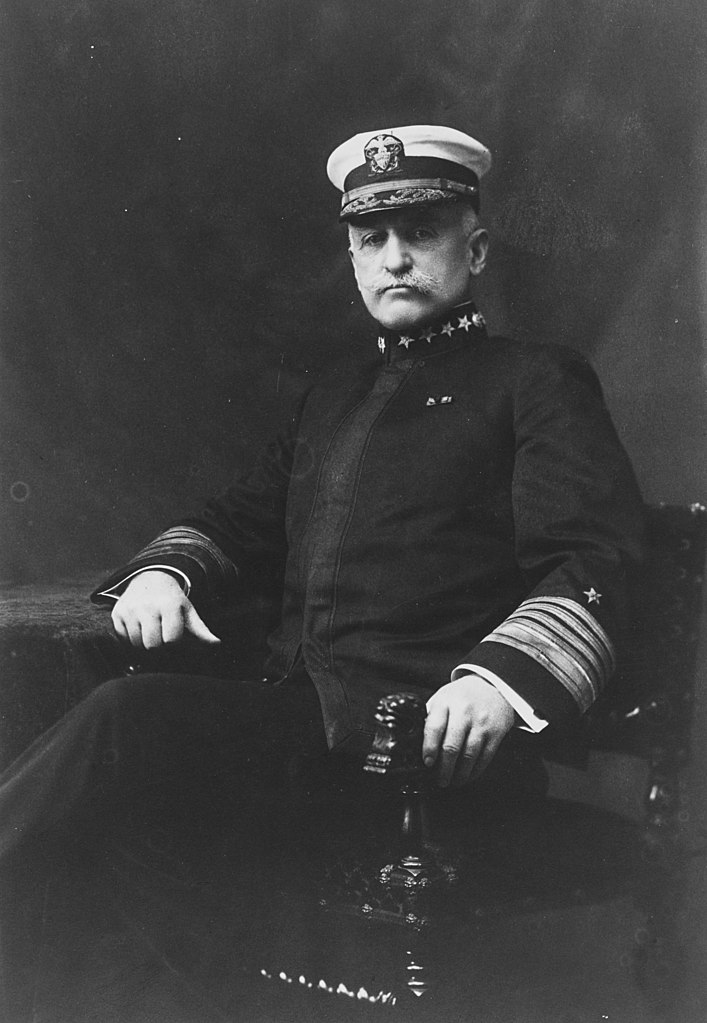
The lead ship of the class was named after William Shepherd Benson, graduate of the Naval Academy in 1877, commanding USS Albany, Missouri, Utah, and the Philadelphia Navy Yard, becoming the first Chief of Naval Operations (CNO) in 1915, inaugurating the position and reading the book about this new discipline, and served as such until he retired 25 September 1919. He died in Washington, D.C. 20 May 1932.
Ships of the Gleaves class (initially known as the Livermore class because the design was standardized with Livermore, DD 429) were built at Federal, Bath, Seattle-Tacoma and five navy yards. They used Westinghouse, GE and Allis-Chalmers turbines and could be identified by their “round” stacks.
Deployment
DesRon 7 which included USS Gleaves was really home of these destroyers. Few sailors ever spoke of the “Livermore class” which was more an admiralty name. Nobody talked about the “Bristol class” either. This partnership between Bethlehem and Gibbs & Cox produced atypical ships, still treaty-peacetime bound and yet perfected and so well useful and well used in WW2.
Notably captains of these brand new ships liked their return to the more harmpnious two-funnel style, but more so, the redundancy and safety of their powerplant thanks to the new echelon configuration. That was their insurance not to be stranded in anamy territory after a lucky hit.
View a complete ship list.
At first glance, these “two-stack Sims” had a indeed the same streamlined sheer strake on the raised forecastle deck, same streamlined bridge except the last ten from Federal Shipbuilding & Dry Dock Co. Kearny in New Jersey and ten from Seattle-Tacoma Shipbuilding which had a modified one. Captains also appreciated their two quintuple centerline torpedo tube mounts.
Destroyer Squadron 7 (on 1 October 1941):
The early Benson serie, which also comprised the Gleaves as both series were both intermingled were in DesRon 7, an old unit re-equipped with these new destroyers. It was originally created in September 1920 as a reserve squadron of 15 destroyers homeported at Charleston in South Carolina (USA), deactivated in July 1922.
It was reactivated in March 1939, and reactivated at Naval Base San Diego, California (destroyers types unknown). In December 1940, the squadron was reformed at NAS Newport in Rhode Island for the neutrality patrols, Atlantic. Then the first Benson-Gleaves arrived between June and September 1940. So that they most of the time had short shakedown cruises going to the essentials for quick fixes and thrown into the quasi-war against German U-Bootes. It was composed of DesDiv 13 and 14.
USS Plunkett, DD 431, flagship Destroyer Division 13:
USS Benson, DD 421
USS Mayo, DD 422
USS Gleaves, DD 423
USS Niblack, DD 424
USS Madison, DD 425, flagship Destroyer Division 14:
USS Lansdale, DD 426
USS Hilary P. Jones, DD 427
USS Charles F. Hughes, DD 428
Destroyer Squadron 11 (1 October 1941):
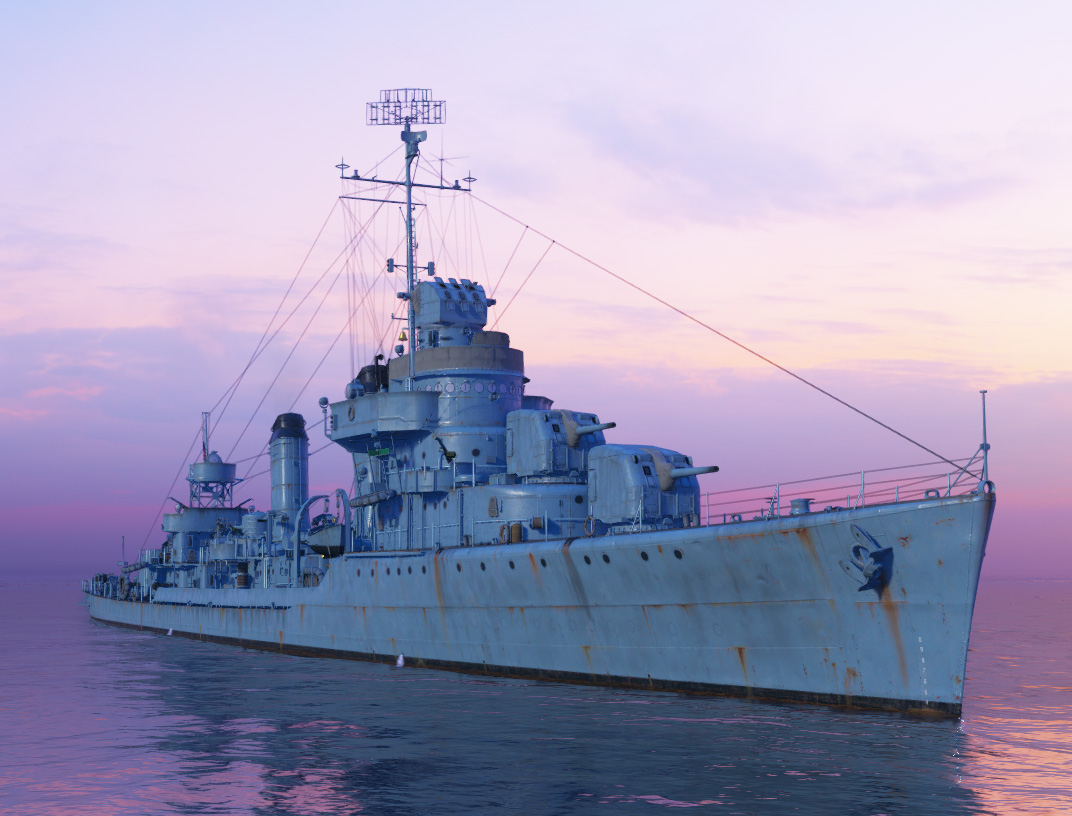
The Gibbs and Cox design follow-up design which had boilers with increased temperatures, were grouped in to DesRon 11. This was an infamous unit, involved in the Honda Point Disaster in the 1920s. From 1939, Destroyer Squadron 11 received new DDs commissioned January and March 1941. After shakedown, they were posted to the North Atlantic Neutrality Patrol. On 17 October 1941, USS Kearny became the first US warship torpedoed by a German U-boat. The unit was composed of DesDiv 21 and 22.
USS Roe, DD 418, flagship DesDiv 21 (first)
USS Livermore, DD 429, flagship Destroyer Division 21
USS Eberle, DD 430
USS Kearny, DD 432
USS Ericsson, DD 440
USS Gwin, DD 433, flagship Destroyer Division 22
USS Meredith, DD 434
USS Grayson, DD 435
USS Monssen, DD 436
24 ships were organized into Destroyer Squadrons 7, 11 and 13. By FY 1941, eight DDs 445–452 were ordered as the first 2,100-ton Fletcher class. December 1940 came and delays with the new destroyer type meant repeat Gleaves and repeat Bensons were authorized in three more groups but they were commissioned with only four 5-inch/38s due topweight issues. Many authors had them classes as the Bristol class (from DD 453) despite the fact they mixed Bensons and Gleaves.
The lead ship already attached to DesRon 13 and USS Barton ended in Destroyer Squadrons 10, 12, and 14–19.
Destroyer Squadron 13 (1 October 1941):
USS Buck, DD 420, flagship I DesDiv 25
USS Woolsey, DD 437, flagship II DesDiv 25
USS Ludlow, DD 438
USS Edison, DD 439
Bristol, DD 453
USS Wilkes, DD 441, flaghip Destroyer Division 26
USS Nicholson, DD 442
USS Swanson, DD 443
USS Ingraham, DD 444
Ships in DesRon 11 (DesDiv 21: Atlantic, DesDiv 22: Pacific) and DesRon 13 retained all torpedo tubes and had twelve .50 cal AA HMGs simply replacing their initial single liquid-cooled models for air-cooled twin mounts. Those of DesRon 7 landed their aft TT and had four more .50 cal machine guns, for 10 total.
General Assessment
These destroyers arrived in time to take the brunt of the most difficult combats in the Pacific. They were already the backbone of the pre-war Neutrality Patrols and after Pearl Harbor, participating in every major campaign of the war. Only a fraction served in the Pacific, as they were the most recent and best design available for operations. The apparition of the Fletcher class no doubt was regarded with envy by the “old salts” which served on the Benson-Gleaves, which looked cramped, unstable, slow and vulnerable in comparison. When Fletchers arrived in service in mid-1942 (USS Fletcher was completed in 33 days, between her launch on 3 May 1942 and 30 June 1942…) the Bensons, and later Gleaves class started to be sent back to the Atlantic (for those which survived).
Thus, between their freshness and availability, they really took the brunt of the fighting in the Pacific, with more losses and more battle starts combined than any other US destroyer class in history -related to their numbers- Indeed, the Fletchers earned more battle stars, but they had another round in Korea and even in Vietnam for some, not even talking of their service under other flags.
Laffey and Barton were lost at the Battle of Guadalcanal, 13 November 1942. Lansdale was lost in the Mediterranean 20 April 1944. Laffey received the Presidential Unit Citation for her role in the Battle of Guadalcanal. Bailey received a Navy Unit Commendation for her role in the Battle of the Komandorski Islands, 26 March 1943. Hilary P. Jones received a Navy Unit Commendation for her role in the final operations in the Mediterranean Sea, September 1944.
In general, their assignment varied wildly. The very first ships went to Atlantic-Mediterranean service and a late Pacific service, just as the late repeat ships, but for different reasons. The late ships were completed in late 1942 and 1943 and after their sjakedown, post-fix and initial training whick lasted for months to shape up the crews, they generally started with costal escort missions, notably to the Carribean, or the east coast, to “get in shape”. But rarely making U-Boat contacts. Then they generally started trans-atlantic convoy duty, generally to North Africa. Their earlier sisters took part in Operation Torch, the late batch to the final North African push to Tunisia and invasion of Sicily, Italian campaign and went on with the invasion of southern france and still lingering for coastal bombardments and patrols on the Ligurian coast against the remaining axis forces, still having E-Boats and MAS-Boats to play with.
This latter batch was recalled for Pacific service, but once they arrived, after an overhaul, on site, it was often too late when they arrived on site. They usually turned out just in time for occupation duties but some were recalled underway and sent straight to Charleston for inactivation.
Which tells something, as these late batch ships were less valuable than Fletcher class vessels and thus, not prime suspect for MSDAP transfer. So their wartime service between 1943-45 was their only subject of attention, and they were all scrapped in 1970-73 after a long reserve time in Texas, at Orange. Three years of service is not a very rewarding time for taxpayer’s money. You’ll judge. Only three ships saw longer service under other flags indeed, the Taiwanese ROCS Lo Yang and Han Yang and Italian Artigliere which also did not see 1975.
And there was the completely different situation of the “middle” batch of Bensons which were sent straight to the Pacific, taking on most difficult missiones and battle of the campaign from Midway to Okinawa. That’s were they earned most battle stars, with the most decorated destroyer being USS Frazier DD 607 with 12 battle stars. In total, the class cumulated c170 battle stars and several citations.

USS Mayo (DD 422) of the Benson class, just completed in sea trials, original configuration, Sept. 1940
(More to come)
⚙ specifications *1940 |
|
| Displacement | 1620 t standard, 2474 t FL |
| Dimensions | 341/348oa x 36 x 17 ft 9 in fl (106.12 x 11 x 5.41 m) |
| Propulsion | 2 shafts Bethlehem GST, 4 Babcock & Wilcox boilers 50,000 shp (37,000 kW) |
| Speed | 37.5 knots (69.5 km/h) |
| Range | 6,500 nautical miles (12,000 km; 7,500 mi) at 12 knots |
| Armament* | 5× 5 in/38, 6× 0.5 in. HMG AA, 2×5 21-in TTs, 10 reloads, 2 DCR |
| Sensors | Mk37 GFCS, SC radar, QC sonar |
| Crew | 208 (276 wartime) |
Near-sisters: the Gleaves class
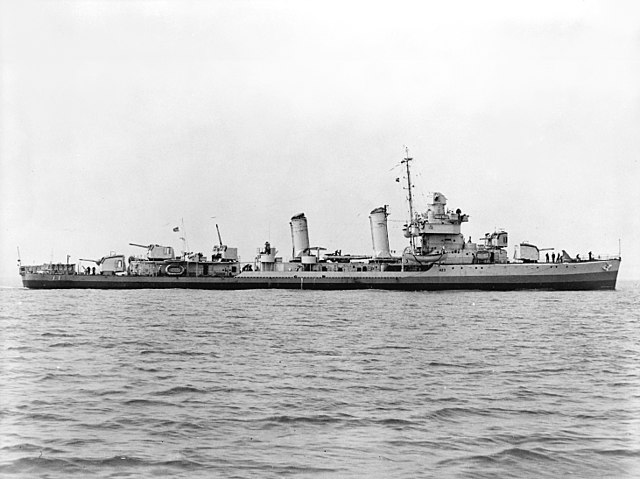
USS Gleaves (DD-423) underway on 18 June 1941, after completion.
The sixty-six Gleaves were built in parallel, and were ten tons heavier but only differed by minor details, yard-based. Distinction between the two classes is rather superficial, as they were virtually identical, only differing by weight and the Benson having flat-sided funnels, whereas they were round on the Gleaves.
They were the last USN destroyers built with a forecastle (no flush deck), but in essence, had the genes of the following Fletchers. They had the same armament of five 5-in/38, six single 0.5 in (12.7 mm) AA HMGs Browning of the liquid-cooled types, and two quintuple TT banks with slightly differing ASW armament.
Production for both classes went on until February 1943 when the USS Thorn and Turner (DD 647, 648) were launched. Most authors and Conways mixed the two classes into one in fact. However a major difference came with the Bristols, from DD 453 onwards, which tended to sacrifice the antiship capability for reinforced AA and ASW capabilities. The biggest difference was the adoption of a more potent and modern AA artillery, sacrificing a turret and TT bank in the process.
The Benson/Gleaves had indeed a subclass known as the Bristol (DD 453) class, 48 ships in all, which were wartime-designed and had four 5-in guns as ordered, four 40 mm AA in twin mounts, seven 20 mm AA and just one TT bank, plus 4 to 6 DC throwers and two DC racks at the stern.
Twenty-one of these Gleaves & Bristol subclass class were in commission when the Japanese attacked Pearl Harbor. Of course afterwards, production was step up and the logical step was to deliver the simplified Fletchers. But in 1941 already, the admiralty ordered simplifications in design to Seattle-Tacoma batch (DD493-497, 624-628) and Federal/Kearny (DD618-623, 645-648) with squred-faced bridges and directors directly on the pilot house rather than suspended on pedestals. After these changes, USS Livermore was tested at 50,400 hp and 37.58 knots at full speed.
In total, sixteen of both class were sunk in action, starting with the USS Meredith (15.10.1940) the USS Lansdale (20.4.1944), Gwin (13.7.1943), Monssen (13.11.1942), Ingraham (22.8.1942), Bristol (12.10.1943), Emmons (06.04.1945), Laffey (13.11.1942), Corry (6.6.1944), Hobson (27.4.42), Aaron Ward (7.4.43), Duncan (12.10.42), Glennon (10.6.44), Maddow (10.7.43), Beatty (6.11.43) and Turner (3.1.44).
Read More
Books
Destroyerhistory.org: Benson/Gleaves ship list
Bauer, K. Jack; Roberts, Stephen S. (1991). Register of Ships of the U.S. Navy, 1775–1990: Major Combatants. Westport, Connecticut: Greenwood Press..
Friedman, Norman (2004). US Destroyers: An Illustrated Design History (Revised ed.). Annapolis: Naval Institute Press.
Gardiner, Robert; Chesneau, Roger (1980). Conway’s All the World’s Fighting Ships 1922-1946. London: Conway Maritime Press.
Gardiner, Robert; Chumbley, Stephen (1995). Conway’s All the World’s Fighting Ships 1947-1995. London: Conway Maritime Press.
Silverstone, Paul H. (1965). U.S. Warships of World War II. London: Ian Allan Ltd.
Links
destroyerhistory.org generalinformationbooks DD-421 Benson (pdf)
navypedia.org/
en.wikipedia.org Benson-class_destroyer
destroyerhistory.org benson gleaves class
www.destroyers.org 20-mm-single-and-twin-mounts/
destroyers.org -quintuple-mk-14-and-mk-15-torpedo-tubes/
web.archive.org destroyerhistory.org/ bensonclass/
destroyerhistory.org/ uss murphy/
history.navy.mil /index-to-vol-23.html
web.archive.org/ Intro-DD423.htm
navweaps.com 5-38_mk12.php
Model Kits
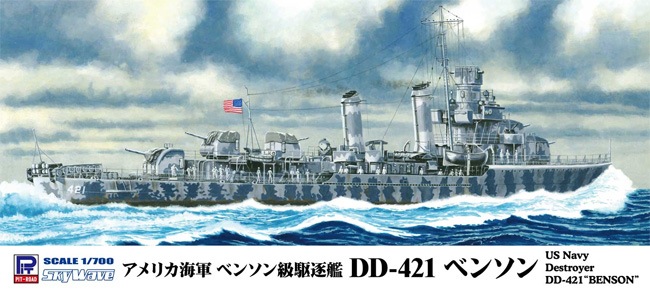
USS Benson 1:700 by Pit-Road. Popular subject due to their heavy WW2 service on the Atlantic, Mediterranean, even Arctic, Nerth and South Pacific and quinky 1942-43 camouflage patterns.
Full query by scalemates
Moderately generous choice starting with the old and strange Monogram 1:261. Well covered otherwise at 1:350 (Blue Water Navy, Yankee Modelworks, Dragon) and 1:700 by CyberHobby, Dragon and Pit Road. There are also 3d printed accessories for the 1:72 anf the massive 1:96 The Scale Shipyard model (as usual, bare fiberglass hull for RC).
3D
Videos
Recent coverage by Drachinfels (July 2023)
The Bensons in service
Early Bethehem Bensons (1940)
 USS Benson DD-421
USS Benson DD-421

USS Benson in 1944 with Measure 32 design 3D (navsource)
Comp. 25 July 1940, USS Bensons made her fitting out at Boston, cruise to Portland and shakedown training to Cuba. Chesapeake Bay, departed Norfolk to Cayenne, French Guiana (Poss. Axis activity, bauxite ore protection) Embarked the governor to Îles du Salut and back to Cayenne. Next, Puerto Rico, New York Navy Yard post-shakedown overhaul.
Neutrality patrols. March 1941 escorted USS Potomac Pdt. Roosevelt to the Bahamas, holidays. Screened USS Texas North Atlantic. Searched for Bismarck. Boston OVL. TF 19 to Iceland. Training Portland, Maine. Northern convoys. March 1942 escort to Londonderry Northern Ireland – Boston. Bermuda Panama convoys. Prepared for Operation Torch. 19 October collided with Trippe, repaired NY. North Atlantic-Mediterranean convoys. July 1943 invasion of Sicily with TG 80.2, convoy NCS-1 to Gela. August TF-81 Italy Landings, Salerno. 11 September, assisted USS Savannah (CL-42) damaged by Luftwaffe. 19 September Salerno shot down Fw 190, shore bombardment missions.
January 1944 ecorted GUS-28 Casablanca-New York. OVL, east coast exercizes. Escorted TG 27.4 in May, then UGS-40. Attacked Luftwaffe, shot two Ju 88 bombers, probable third, damaged two more.
Mid-August 1944 TG 80.6 for Operation Anvil Dragoon. Battle of Toulon, supported French cruisers Montcalm and Jeanne d’Arc off San Remo. January 1945 Livorno shore bombardment attacked by E-boats/MAS boats, escorted Georges Leygues off Pietra Ligure.
Pacific service:
January-Feb 1945 OVL, escort to UK and back, crossed Panama Canal 12 May, Pearl Harbor. From 14 June escorted USS Lexington (CV-16), USS Cowpens (CVL-25) and USS Hancock to Wake Island. Ulithi-Okinawa, escorts until 15 August. Postwar, escorted 5 convoy groups to Tokyo Bay, occupation duties. Back Charleston 6 December. Decommissioned 18 March 1946, reserve Atlantic Reserve Fleet (4 battle stars). 26 February 1954 transferred to the Republic of China Navy as Lo Yang (DD-14), service until mid-1970s, stricken November 1974.
 USS Mayo DD-422
USS Mayo DD-422
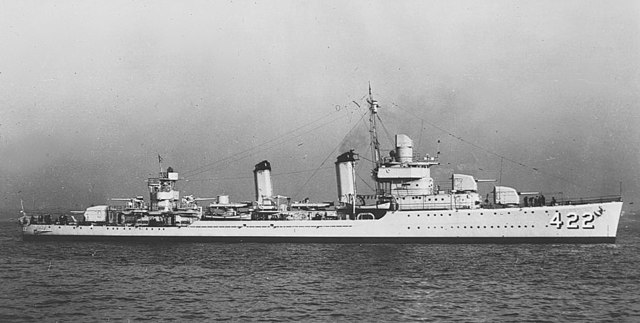
Comm. in 18 September 1940, USS Mayo joined the Neutrality Patrol after shakedown. Escorted Marines to Iceland July 1941. Escorted the route to the Atlantic Charter conference August 1941 off NS Argentia, Newfoundland. HP Boston convoys summer 1942 and New York City. Rescured SS Wakefield 3 September. Operation Torch Casablanca 12 November. Returned with DesRon 7, 8th Fleet Mediterranean August 1943. Landings at Salerno 8 September, Landings at Anzio 22-24 January 1944. On 24th hit a mine (7 killed, 25 wounded). Towed back to Naples, temp. repairs, 3 March towed to New York NyD 5 April, 4 months repairs. Made 4 more convoys to Europe before V-Day. 5 May 1945 departed for western Pacific via Pearl Harbor, TG 12.4. Ulithi, escorts to Okinawa. Covered landong on Honshū 2 September. Escorted troopships from the Philippines and Okinawa. 5 November dept. for San Diego, Charleston, 7 December. Decommissioned 18 March 1946, reserve Orange, Texas, stricken only by 1 December 1971, sold 8 May 1972, BU. 2 battle stars.
 USS Madison DD-425
USS Madison DD-425
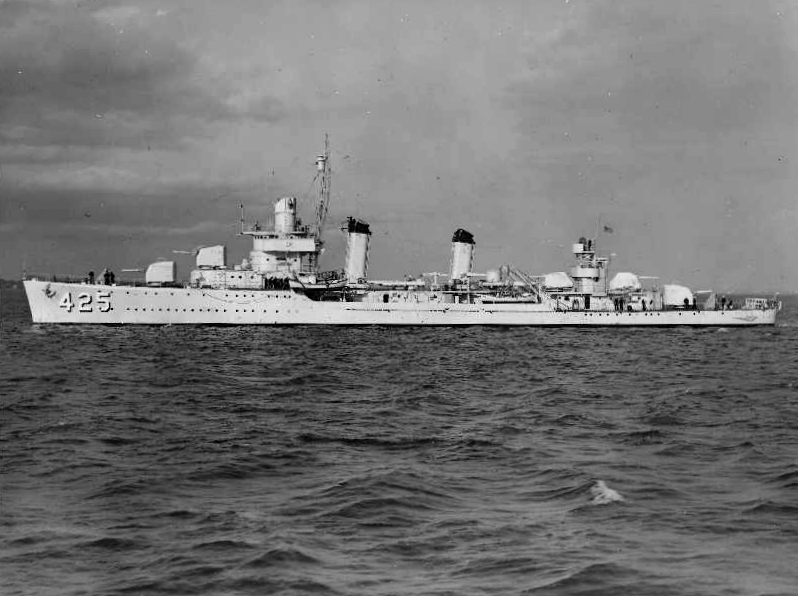
Com. 6 August 1940, USS Madison took part in Neutrality Patrols, Caribbean and North Atlantic convoys and two diplomatic voyages by January 1941 (escorted Tuscaloosa, Admiral Leahy to Portugal and France as Ambassador to Vichy France) and by In August (Augusta, President to Argentia Bay conference).
North Atlantic-east coast convoys until spring 1942. Scapa Flow, Home Fleet April 1942, Greenock to Mediterranean route. Escorted USS Wasp carrying spitfires to Malta. Patrolled North Sea, convoy routes to Murmansk.
Operation Torch from 2 November and New York City-Casablanca, convoy UGF 2. Operated off Casablanca, Convoy duty. Operation Shingle, escorted convoy from NY 30 January 1943 to Derry, Northern Ireland and “oil runs” Curaçao-UK. Continued Netherlands West Indies, New York, north Africa.
Algeria 30 January 1944, landings at Anzio, ASW patrols, AA protection, support gunfire. Then Mediterranean convoys. August 1944 support force Operation Dragoon, ASW patrol, fire support. 10 September four certain kills of human torpedoes, one probable.
Back US January 1945, last convoy Mediterranean, east coast 21 April, transited Pacific, Guam 1 July. Convoys to Okinawa and back, picket station Ulithi. 2 August seach for USS Indianapolis survivors. Tokyo Bay, surrender. Occupation forces until 5 November. Charleston, refit after 300,000 miles (550,000 km), 7 December 1945. Decom. 13 March 1946, moed to Orange, Texas, stricken 1st June 1968. Sunk as target off southeastern Florida, 14 October 1969.
She earned 5 battle stars.
 USS Landsdale DD-426
USS Landsdale DD-426
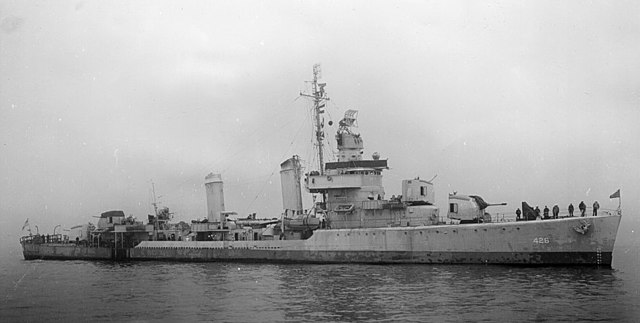
USS Landsdale was commissioned on 17 September 1940 at Boston. Shakedown Caribbean, and from 18 January 1941 Neutrality patrol, Caribbean. Escort training Atlantic coast. HP Argentia 30 June, to Iceland, 3 escort runs. Escorted seven troopships New York-Key West 22–27 January 1942. HP Maine, plane guard USS Wasp. ASW patrols/escort eastern seaboard-Iceland Caribbean and Panama Canal or Gulf of Mexico.8–21 May Puerto Rico-Bermuda with USS Savannah and Juneau.
9-18 August to Northern Ireland, Lisahally, Greenock-New York 5 September and another run. 10–21 October screened USS Arkansas. Joined TF 38 and convoy UGF 2 to north Africa, Safi French Morocco 18 November. Next New York convoy 41 transports. 10 January 1943 OVL. Convoy Northern Ireland, Derry 9 February. Joined 42nd British Escort Group, escorted tank convoy UC 1 to West Indies. Off Azores 23rd attacked by German wolf pack (6-10 U Bootes). Lansdale made several ASW runs and later hit submerging U-boat with gunfire. Trinidad 6 March, escorted SS Maasyerk. Curaçao, more escorts, 8 runs 20 March-6 October to UK, 3 Curaçao-New York and to Puerto Rico and Virgin Islands.
Run to Casablanca and back (3 November-17 December) and again on 13 January 1944, Casablanca 1 February, Oran, Algiers, Tunis, escorted USS Brooklyn to Algiers and Pozzuoli Italy 14 February, Anzio Landings. Until returning to Oran from 22–26 March, she searched for German submarines and screened the light cruiser Philadelphia, fire support, shore bombardment.
Escorted convoy UGS 37 (60 merchant ships, six LSTs) Ny-Bizerte. 11 April 23:30 attack by 16-25 Dornier-Junkers bombers off Cape Bengut in Algeria. Success. No ship sank, 4 planes shot down.
Other escort Oran-US convoy GUS 36. Later UGS 38 back to Bizerte as “jam ship” (against radio-controlled bombs). 20 April 21:00 Luftwaffe raid. 18-24 Junkers-Heinkel bombers, three waves. SS Samite hit by torps. bombs SS Paul Hamilton (exploded, sunk), two more 2ns wave. Third wave 5 Heinkel He 111s with torps attacked USS Lansdale at 21:04, from both port and starboard. All missed but attacked by five Ju 88s with torps. One shot starboard, but another placed a torpedo starboard side 21:06. She took a 12° list, rudder jammed 22° starboard, flloded, reduced 13 kn, clockwise circle. 21:12 new attack, two torpedo bombers, missed, shot down one.
21:20 list increased to 45°. Captain Lt. Cdr. D. M. Swift ordered to abandon ship to avoid roll over. 21:30 listed 80°, break up and at 21:35 broke in half. Two destroyer escorts returned next morning, picked up 115 and 119 survivors. She sank with 47 officers and men. Lt. William B. Neal, Jr. cited was awarded Navy and Marine Corps Medal.
She earned 4 battle stars.
 USS Hilary P. Jones DD-427
USS Hilary P. Jones DD-427
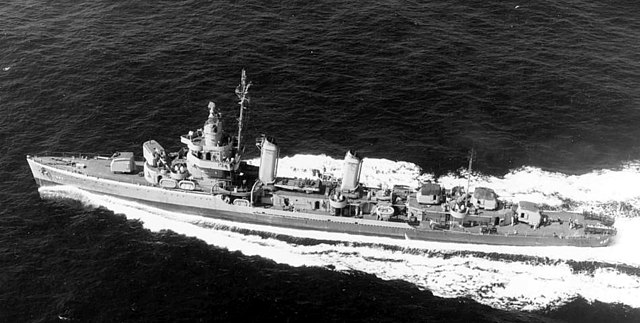
Commissioned 6 September 1940 at Charleston NyD, after her shakedown and exercises, started on 11 December Neutrality Patrol duties in the Caribbean. Escort until 11 March 1941, Hampton Roads. Training off New England, dept. New York first convoy escort to Newfoundland, and Iceland. Rescued survivors from USS Reuben James. Transferred Mediterranean January 1944, screen USS Philadelphia off Anzio. Anzio-Naples until 20 March, gunfire support until May. Attacked U-516 off Algeria, sank on 17 May.
Took part in Operation Dragoon from Naples 13 August, convoy with French and British ships. Gunfore support, electronic jamming vessel. Supported First Airborne Task Force. Attacked by E-boat 21 August, destroyed. Received the Navy Unit Commendation. Convoy duties Mediterranean, then New York 12 January 1945, OVL. Last transatlantic convoy 26 February–9 April 1945. Dept. NYC 24 April for Panama Canal, Pearl Harbor 18 May 1945 to 2 June, Ulithi 13 June, sailed to Caroline Islands and Okinawa. 18 August Okinawa, Subic Bay, Tokyo. Supported 8th Army occupation troops, entered Tokyo Bay 2 September, surrender. Two more voyages and back US 5 November. Charleston Navy Yard, decommissioned 6 February 1947 Atlantic Reserve Fleet. Loaned ROCA under MDAP 26 February 1954. HanYan (DD-15) until stricken 1 November 1974, BU. 4 battle stars.
 USS Charles F. Hugues DD-428
USS Charles F. Hugues DD-428
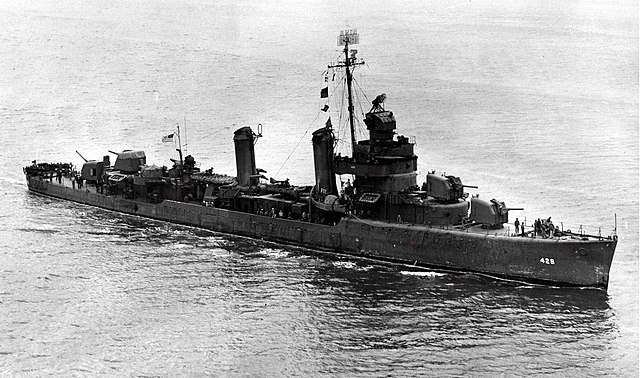
Commissioned 5 September 1940, after shakedown and training Caribbean, reported at Newport 3 April 1941, convoy escort western Atlantic. Rescued survivors from sunken merchantmen, USS Troopship and torpedoed Norwegian freighter. Coastal convoys in early 1942, Caribbean and mid-ocean meeting points Iceland-New York. Until 19 May 1942 first complete crossing of the Atlantic Belfast to Boston. August 1942, transatlantic convoy duty. First convoy UGF 2 to North Africa, Casablanca 18 November. Regular UC and CU convoys of tankers Bristol Channel, Netherlands West Indies in 1943. Also convoys Casablanca-New York until December 1943. 4 January 1944 dept. Norfolk to 8th Fleet Mediterranean, took part in Anzio landings, HP Naples.
3 March to 4 April 1944 resumed convoy duties, north African waters ti Gibraltar and back Anzio until May. Naples 30 July 1944 prepared for Operation Dragoon. Night 19/20 August, spotted three German E-boats, beached 2, sank a third. Gulf of Genoa 7-16 December call-fire support off Monaco.
Back to Brooklyn OVL 12 January 1945, final convoy to Oran. Reassigned Pacific. Arrived Ulithi 13 June, co,voys to Okinawa, present in Tokyo Bay Surrender 2 September 1945. Until October, convoys from Ulithi-Philippines to Japanese ports. Nov. dept. for Charleston, arrived 7 December, decomm. 18 March 1946. Sunk as a target 26 March 1969. 4 battle stars.
Repeat Bensons (1942)
 USS Laffey DD 459
USS Laffey DD 459
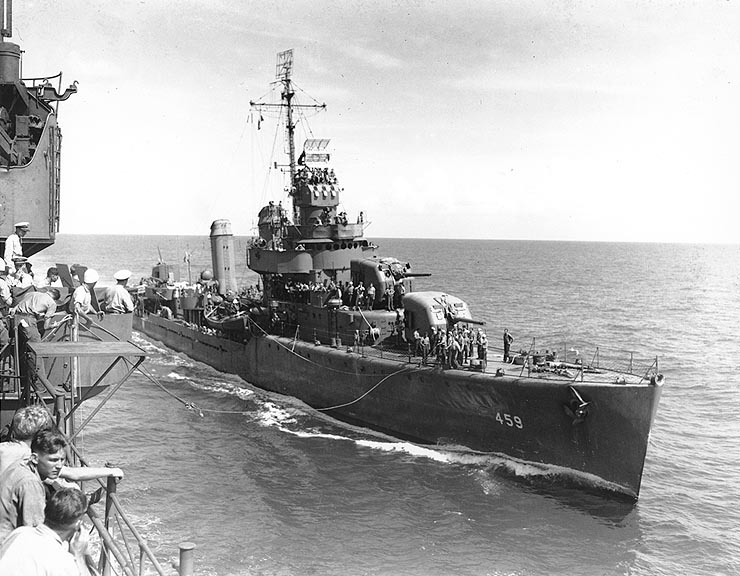
USS Laffey was a “repeat benson” and like most of her late sisters, went straight to the boiling cauldron of the Pacific when commissioned on 31 March 1942 (Lt. Cdr. William E. Hank in command, Kia Guadalcanal). Shakedown-training off west coast, assigned to the Pacific. Pearl Harbor, Efate 28 August 1942. ASW screen and TF 18 6 September, USS Wasp. When sunk 15 September, rescued survivors. Espiritu Santo, joined TF 64 to Noumea New Caledonia 18 Sept. Took part in the Battle of Cape Esperance (Second Battle of Savo Island) 11-12 October 1942 under Admiral Norman Scott cruiser group. Was with two other destroyers in the van of the line. She raked cruiser Aoba with three 5-inch guns. Returned to escort Nouméa 11 November to Lunga Point. 13 November van column of eight destroyers, five cruisers (Admiral Daniel J. Callaghan) at the Naval Battle of Guadalcanal. Laffey opened with gunfire and torpedoes, narrowly miss-collided with IJN Hiei by 20 feet, sent torpedoes and hit her bridge with gunfire wounding Admiral Abe, and killing the XO. She spotted another battleship to her port beam, two destroyers on her port bow but had two main battery guns HS and no torpedo left. No-quarter duel at point-blank range, hit herself by a 14-in from Hiei, torpedo in her fantail which lef her dead in the water. Aabandon ship but violent explosion, sank immediately with a large part of her crew. She had 59 killed including CO William E. Hank and 116 wounded. Awarded later a Presidential Unit Citation and 3 battle stars.
 USS Woodworth DD 460
USS Woodworth DD 460

USS Woodworth was another “repeat-benson”, commissioned on 30 April 1942, spent 4 months fitting out/training/shakedown and was sent in escort duty, Southwest Pacific between Australia and Guadalcanal. Attached to TF 65, January 1943 off Espiritu Santo in the New Hebrides. 2 February placed under TF 69, VADM Richard P. Leary from flagship USS New Mexico. Merged with TF 18 (Flag Wichita, two aircraft carriers, three light cruisers, four destroyers, oiler). Patrols and escorts Solomon Islands & New Hebrides, Fiji Islands 1 March. Joined TF 15 (USS Enterprise) Espiritu Santo and Solomons, Tulagi 5 April.
7 April, while escorting oiler Tappahannock Solomons, air attack (six planes) off Rua Sura Island. Four near miss Tappahannock. No damage. Training-escort-patrol between New Hebrides and New Caledonia in May and until 29 June escorted transports to Guadalcanal and screened TF 10. OVL New Zealand. 30 June, while en route to Rendova, air attack by 12 torpedo bombers. Dodged but one casualty, superficial damage by MG hits.
2 July 1943 with USS Jenkins bombarded Jap positions on Wickham Island in New Georgia. Tulagi, Port Purvis, Florida Island, Rendova Harbor, Rice Anchorage July 1943, landing operations. With USS Kilty, Crosby, Schley, second landing operations at Rice Anchorage. Later attacked sub I-25.
13 July TG 36.1, took part in Battle of Kolombangara. Fired four torpedoes, fifth misfired. Struck to the stern by Buchanan, screened cruiser St. Louis hit by torpedo. No casualties.
Patrol/Escort between Espiritu Santo and Guadalcanal until 7 October. joined TF 38., screened carriers Saratoga and Princeton. Raids on Buka, Rabaul. Detached 14 November, Guadalcanal escorted Pinkney, patrol until late December with TG 36.1. 26 December left Espiritu Santo loaded with 1,500 rounds of 5-in, 1,500 rounds 5-in powder charges to Port Purvis.
8 January 1944 took part shelling Shortland Islands. Patrolled Bismarck Archipelago until 13 January; joined DesRon 12 (Farenholt, Lansdowne, Buchanan) shore shelling northeast coast of Bougainville. Routine escort until 13 February 1944 and went to Australia for rest.
13 February with TF 38 was present at the assault on Green Island, attacked by six Vals on the 14th. Shot one. 14-15th, antishipping sweep St. George’s Channel, Rabaul. 17-18th, shelled Rabaul, fired torpedoes at 2 ships leaving Simpson Harbor and others at Kervia Bay. 24th while sweeping along Truk-Kavieng radar contact with Japanese merchant vessel and tanker, fired 38 rounds, later sunk by DesDiv 24, dodged shore batteries fire. Sunk two, damaged another, destroyed barges, engaged shore batteries.
1-21 March training, escort, ASW and barge-hunting in the Solomons. Back Pearl Harbor for short refit. Joined TG 35.6. Sent San Francisco, OVL Mare Island 15 April 1944. 21 July Operational, after training, joined TG 12.1 (presidential cruise) with USS Dunlap, Cummings, Fanning, cruiser Baltimore carrying President to Pearl Harbor for conference with Admiral Chester Nimitz, General Douglas MacArthur. Escort went to Alaska, Aleutian Islands and Bremerton. Woodworth was back to San Francisco 14 August 1944 and returned for Pearl Harbor. 30 September Ulithi Atoll for ASW patrols, joined TG 38.1.
Late 1944 sustained mid-refueling collision. After repairs screened an air strike on Okinawa 10 October and northern Luzon, Formosa. Was picket ship 12 miles east when attacked by torpedo planes at 18:15. No hit. Later heavy weather damage. 12th, attacked by 5 land-based 2-engine bombers. Shot down one, later assisted Canberra. 14th third wave, she claimed three with her new Mk 32 fuses shells, spent 75% stock.
On 15 October raids on Luzon, detached from TG 38.1, Leyte Gulf with TG 30.3, Ulithi. Routine duty Eniwetok, Palau (Peleliu, Angaur) and Leyte Gulf. With TU 94.18.12 15 January 1945 for gunnery practice became flagship, Capt. W. P. Burford as station ship off Kossol Roads and Ulithi Group. Patrolled southwest of Okinawa 9 May, escorted USS Makin Island to Kerama Retto. 10 May-28 May escorted CVEs during strikes on Okinawa. Escorted USS Natoma Bay to Kerama Retto, later assisted Natoma Bay hit by Kamikaze. Next screen carriers, raids on Kyūshū and Ryukyus until 21 June. 22-23 radar picket duty off Okinawa. Leyte Gulf refit 1- 10 July, escorted the logistic train of TF 38 in July.
2 August 1945 eszcort oiler Neshanic to Ulithi. 14th ordered to proceed to Iwo Jima to pickup mail and passengers. 22 August joined USS Ticonderoga, first occupation force. 10 September was in Tokyo Bay. 1 October, to Okinawa, 6 October went home with passengers, Portland 19 October, San Pedro.
Transferred Atlantic Fleet November, Charleston, OVL, decommission, reserve 11 April 1946. 30 January 1947 Naval Reserve training duty. Full commission 21 November 1950, 3rd Naval District, decommissioned New York 14 January 1951, OVL for MDAP transfer to Italy. Renamed Artigliere (D 553) 11 June 1951, served until January 1971 but used for turbine instruction for naval cadets La Spezia until May 1983, sunk as target by sub. Nazario Sauro.
 USS Farenholt DD 491
USS Farenholt DD 491
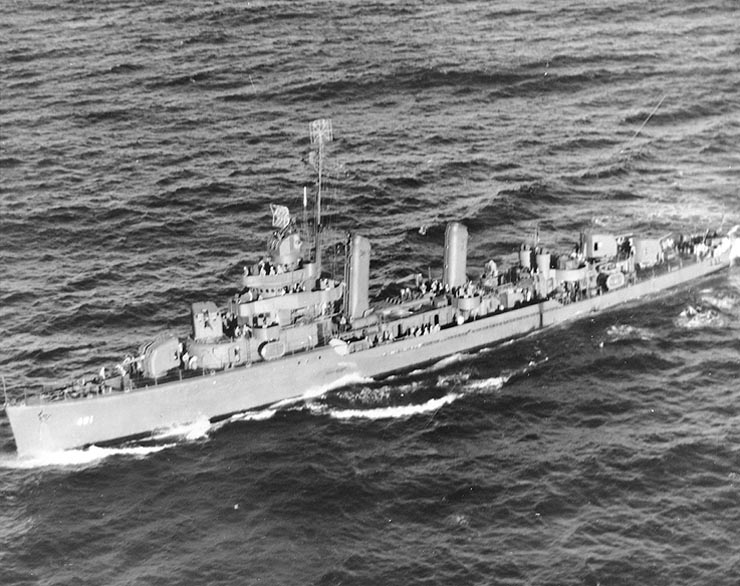
Third of the repeats, USS Farenholt was commissioned 2 April 1942. From San Diego she sailed on 1 July 1942 for Tongatapu (Tonga) and on 23th shore bombardment exercises. Joined TF Wasp, took part on 7 August Invasion of Guadalcanal, screening Wasp as flagship DesRon 12. Escorted reinforcements from Espiritu Santo to Guadalcanal. Later rescued 143 survivors from Wasp and staff, landed in Espiritu Santo. Returned Nouméa for occupation of Funafuti. Espiritu Santo 6 October joined a force sent to intercept “Tokyo Express”. Night 11/12 October, Battle of Cape Esperance. She sank a Japanese destroyer, received three hits (3 killed, 43 wounded) but hit a cruiser and a destroyer. Limped back to Espiritu Santo 13 October.
Full repairs Pearl Harbor, Espiritu Santo March 1943. Escorts to Solomon Islands. Lunga Point 6 April, engaged enemy bombers and 7th, another attack in Sealark Channel (14 torpedo bombers) claimed one. Had a near miss. Back to Solomons 30 April. 13 May drove off air attack, 30 June engaged shore batteries New Georgia, Munda and Rendova. Later air attacked, avoided two torpedoes, struck by a third (dud). Embarked RADM Richmond K. Turner.
Escorted support shipping lower Solomons, shore bombardment until 16 July. Escort duty Efate and Nouméa-Guadalcanal, resupplied Vella Lavella. Visited Sydney. Later screen TF 58 to Bougainville, Buka and Rabaul. Until February 1944 she escorted reinforcements and supplies to Empress Augusta Bay, shelled Choiseul and other points Bougainville and Shortland, covered landings Green Island, sweeped St. George Channel, bombarded Rabaul, sunk two merchantmen, destroyed shore installations. Did the same on Kavieng on 25th but counterfire, holed at the waterline starboard.
Repaired Purvis Bay, West Coast overhaul. Back 16 June 1944 via Pearl Harbor to Guam 21th, screened transports landing assault troops. Next, Palaus operation. Screened carriers to Palaus and southern Philippines, shelled the radar station on Cape San Augustine (Mindanao) and supported landings on Morotai and Angaur. Until 13 October replenished at Manus. Assisted assault on Leyte 20 October. Took part in Battle for Leyte Gulf. Escorted the damaged cruisers Canberra and Houston to Ulithi.
Still flag DesRon 12, Western Carolines-Marianas Patrol/Escort Group, station ship at Ulithi, Kossol Passage, escorts until 5 May 1945. Okinawa, various tasks. Resplenished/refit at San Pedro Bay 19 June, joined logistics group, fast carriers Force striking the home islands. 28 July was off Okinawa, screening duties, until 22 September, carried an Army general to accept Japanese surrender southern Ryukyus, Sakishima Gunto. Untl 31 October Buckner Bay – Sasebo ezcorted occupation troopships. Returned to San Diego and Charleston 8 December. Decommissioned, reserve Charleston 26 April, 25 years reserve fleet, stricken June 1971, sold for BU November 1972. 11 battle stars.
 USS Bailey DD 492
USS Bailey DD 492
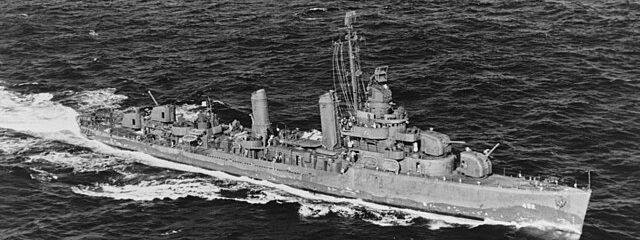
USS Bailey was commissioned on 11 May 1942, assigned to the Pacific Fleet. After training and shakedown, she joined TF 8 patroling the Aleutian Islands. On 12 January 1943 she supported the landings at Amchitka. On 26 March she took part in the Battle of the Komandorski Islands under command of LCDR John Atkeson. She made a torpedo attack, and hit by gunfire IJN Nachi, but received 3 direct hits (5 Kia, 6 wounded). She was later awarded the Navy Unit Commendation. After temp. repairs at Dutch Harbor in Alaska she had full ones at Mare Island from 8 April 1943 until the better of the year, to give an idea of the extent of the damage by Nachi’s 8-in shells.
She was in Pearl Harbor on 16 October 1943. Between November 1943 and October 1944 she was used for fire-support, picket, patrols, taking part in the invasion of Tarawa, Maloelap, Kwajalein, Marshall until 29 February 1944, Saipan and Tinian, Marianas until 28 July, Peleliu and Angaur and the Palau Islands from 15 September to 2 October 1944.
Night of 1 October, two Japanese strafing attacks while on picket duty, extensive damage (9 killed, 16 wounded) after emergency repairs she returned again to Mare Island from 25 October but was back to Pearl Harbor on 24 December 1944 and for the landings on Mindanao from 10 March to 10 April 1945, and took part in the Borneo landings from 27 April to 22 July. Until November 1945 she trained in Far Eastern waters. She was back home, Boston, on 11 December 1945, for inactivation, decomm., reserve at Charleston on 2 May 1946. After a long reserve she was stricken on 1 June 1968, sunk as a target off Florida, 4 November 1969. Her service in WW2 won her 9 battle stars (plus a Navy Unit Commendation).
 USS Bancroft DD 498
USS Bancroft DD 498

USS Bancroft was commissioned on 30 April 1942, assigned after abbreviated shakedown and training to the Pacific Fleet. Like her sister Bailey she started her service in Alaska, wih the operations from Dutch Harbor on 17 September 1942. She took part in various operations in the Aleutian Islands until late August 1943, with the occupation of Amchitka, Attu and Kiska. On 18 August 1943 she assisted the damaged USS Abner Read (stern blown off near Kiska by mine) and prilously extracted from a Japanese minefield. Between September 1943 and July 1945 she performed all the duties of a destroyer between fire support, screening, and escorts, taking part in the Wake Island raid, the Tarawa, Gilbert Islands raid, Kwajalein in the Marshalls, Mille Atoll and the Palau Campaign, landings on Palau and Woleai as well as the Hollandia operation and the Truk-Satawan-Ponape raid, the operation on Wotje Atoll and Saipan occupation, Maloelap Atoll raid and the whole Philippine campaign until 12 April 1945 as well as the Borneo operations from 1 May to 5 July. She learned about the capitulation while resplenishing. Between September and November 1945 she escorted troopships of the occupatio,n force from the Philippine and Okinawa to Japan. She was relieved from duty on 9 December 1945, headed back to Norfolk, to be decommissed, reserve at Charleston on 1 February 1946 until stricken in 1972 and sold for BU in 1973. She was awarded 8 battle stars.
 USS Barton DD 599
USS Barton DD 599
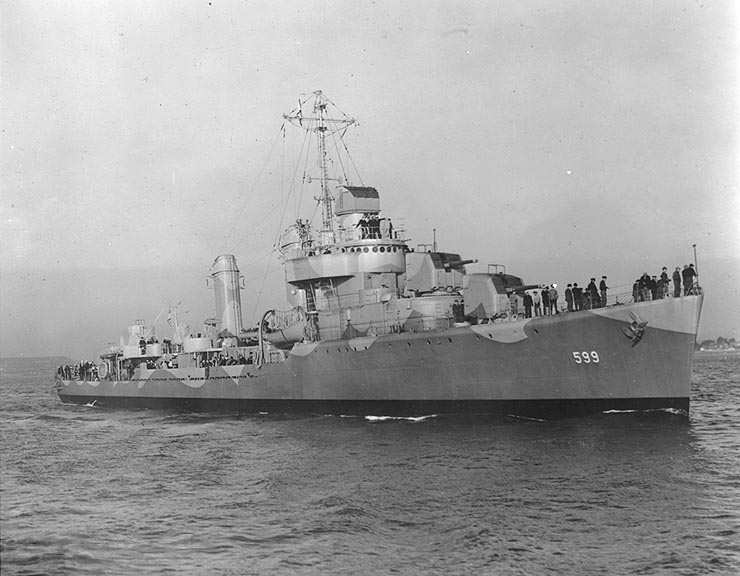
USS Barton was commissioned on 29 May 1942 (LtCdr Douglas Harold Fox) and after a short shakedown and training sessions she departed on 23 August 1942 for the Pacific, starting with a stop at Tongatapu (Tonga Islands) on 14 September 1942 and starting with the Buin-Faisi-Tonolai raid on 5 October 1942 also taking par tin the Battle of Santa Cruz on 26 October, claiming her first Japanese planes. On 29 October she rescued 17 survivors men from downed air transports off Fabre Island. She was off Guadalcanal on 12 November 1942, escorting a supply convoy and joined RADM Daniel J. Callaghan task force to ambush the Japanese in ‘, 11th in the column before sundown, battle stations and later in bad weather detecting the IJN entering Ironbottom Sound at 1:10 am , making eye contact at 1:30 am at 3,000 yards in the squall. Fore erupted at 1:48 am in what became the First Naval Battle of Guadalcanal.
Barton and Monssen were astern and broke the Japanese encirclement northwest, firing at point blank range and dodging collisions and torpedoes, firing herself her full spread at IJN Hiei when she tried to avoid the bow of USS Helena. She made an emergency stop but as her crew tried to get her engines back into gear sailors spotted the wake of two ‘Long Lance’ torpedoes from IJN Amatsukaze. One hit near a boiler room and another the engine room, the massive explosions broke her in two, with both sections sinking in minutes with 164 men, but 42 were rescued by USS Portland and 26 by Higgins boats from Guadalcanal. Despite her short service she earned 4 battle stars.
 USS Boyle DD 600
USS Boyle DD 600
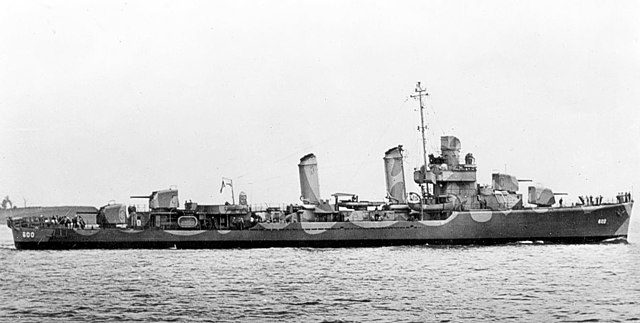
USS Boyle was commissioned 15 August 1942. She joined the Atlantic Fleet, HP Norfolk on 25 October 1942 to join TF 34 for the invasion of North Africa, Operation Torch set in November. She took part in the landings at Fedhala in French Morocco (8–11 November) and fought French corvettes off Casablanca on 10 November. She was back to escort duties along the east coast in December. This went on until February 1943.
Until 4 April 1944 she made six transatlantic convoy runs either to North Africa or to Ireland (3 each). On 7 February 1943 she was escorting Convoy UGS-5 to North Africa when SS Pan Royal was accidentally rammed by SS Evita and George Davis. The first sank with the loss of eight men but 54 survivors were picked up by Boyle. She was detached later for Operation Husky, the Sicilian invasion, acting as guide ship for the Scoglitti landings on 9–15 July. Next she was assigned to a hunter-killer group operating from New York in April 1944. Later she returned to the Mediterranean Sea, based in Naples for various missions. She took part in the shelling of Formia and Anzio on 13–18 May. Until September, she also took part of Operation Dragoon, the Invasion of southern France. She ws back home at New York, and later had a long overhaul from 14 September at Boston. She was back to the Mediterranean by 21 December 1944, performing various duties until 22 April 1945. On 1 May as the war in Europe was nearly over she was reassigned to the the Pacific, via San Diego (12 June), Pearl Harbor (17 July) and arrived in Saipan on 5 August, shalling Wake Island on the 1st. She was off Okinawa on the 12th for patrols until 1 September, arrived in Tokyo Bay on 11 September, and later returned to Okinawa, the leaving for home on 1 November. While in Charleston on 8 December 1945 she was decommissioned, reserve, on 29 March 1946, stricken on 1 June 1971, sunk as a target on 3 May 1973, off Florida.
4 battle stars.
 USS Champlin DD 601
USS Champlin DD 601

Commissioned on 12 September 1942, USS Champlin proceeded to the usual shakedown-training and started soon her first mission, escorting a convoy to NS Argentia (Newfoundland) and another Panama. Based from New York she departed on 11 December 1942 for a reinforcement convoy to Casablanca and back on 7 February 1943. She made another such run on 4 March. On 12 March off the Azores she investigated a radar contact and surprised a surfaced U-Boote, opening and try to ram her, while crashing dive. She then dropped depth charges and sank U-130. Despite her effort the shadowing wolfpack managed to sink three transports. Champlin rescued Wyoming’s 127 men and those from Molly Pitcher. She was back in Boston on 15 April.
She departed NYC on 1 May 1943 to Bermuda and Oran (26th) and Gibraltar, later training in the western Med. On 5 July she left Oran for Operation Husky, and assisted landings south of Scoglitti on 9 July. She notabl on-demand shelled the axis fortified village of Camerina with such precision the troops there surrendered almost without a fire being shot.
She escorted a convoy Oran-New York (4 August) followed by four more Atlantic crossings to North Africa or British waters until 11 March 1944. By March 1944 she was detached for a submarine hunt, notably all 7 April and by 16:32 made contact, dropped depth charges and forced the U-Boote to the surface, soon taken under heavy fire, and rammed her stern for good measure. Thus she claimed her second clear cut kill, U-856. Cdr. John J. Shaffer III was wounded by a 88mm shrapnel however and died the next morning. The destroyer later had her bow repaired, and departed on 21 April 1944 for a new convoy. On 15 May she was directed to Naples and operations off Anzio. From Palermo later she took part in Operation Anvil Dragoon. She patrolled southwest of the transport area (reserve fire support unit). On 19 August she duelled with Cannes shore batteries, silenced the 20th. The following day she duelled by night in the Gulf of Napoule while German E-boats. She destroyed a bridge across the Var River on Army request on 24 August. Back to Oran she escorted a convoy to New York, screening battleships. By 6 January 1945, she returned to Oran. On 30 January she was detached to escort the fleet carrying the president to Malta ans from there, the Yalta Conference. On 20 February she patrolled the western Mediterranean. On 22 April she sailed from Oran to New York, later being assigned after leave to the Pacific. Crossing the Panama Canal on 4 June 1945, she was in Pearl Harbor on 10 July and took part in the attack on Wake Island, arrived at Okinawa on the 12 August, for escort missions until 4 September, then swapped to occupation duties, and by 31 October departed Okinawa with servicemen aboard, via Saipan and Pearl Harbor to San Diego (21-24 November), crossed the canal and was in limited commission, reserve at Charleston, on 28 March 1946 and full decom. on 31 January 1947, soldon 8 May 1972 for BU.
6 battle stars.
 USS Meade DD 602
USS Meade DD 602
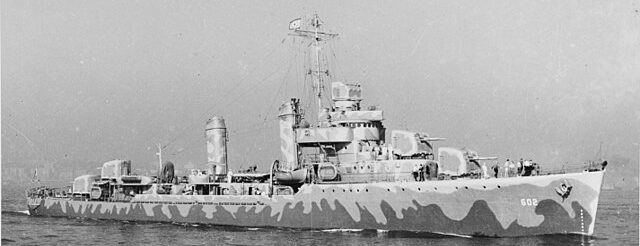
USS Meade was commissioned at Brooklyn Navy Yard 22 June 1942, made a quick shakedown and training in Cuba, and then escorted USS Washington to the southwest Pacific. Tongatapu (14 September) Fast carrier task group, Solomons. HP Nouméa, escort convoys to Guadalcanal.
Too part in the battles of 13 November and 14-15 November off Tulagi and Ironbottom Sound. Destroyed IJN transports off Tassafaronga. Rescued 266 from USS Preston and Walke. Searched for survivors from USS Juneau. Until 16 December escorted shups, screened USS Portland to Sydney and Minneapolis to the New Hebrides. During the Battle of Rennell Island, screened TF 18 carriers.
18 March departed north to the Aleutians. From 15 April, 4 months patrol/escort, fire support on Attu (11 May) and Kiska. Back home, OVL Puget Sound. Pearl Harbor, Wellington NZ 29 October, joined 5th Fleet, Efate, part of fire support group, southern TF 53, to Gilbert Islands. Screened cruisers, shore bombardment on Betio, Tarawa, 20 November.
Made contact on the 22t and chased sub 15:30 to 17:36, surfaced I-35, sunk by gunfire 17:55 after rammed by USS Frazier.
Pearl Harbor 7 December 1943, invasion of the Marshalls with TF 52 (22 January 1944), shelled Taroa island (Maloelap). Kwajalein, screened battleships in shore bombardments. Spotter‑directed gunfire on 1-2 February and patrolled until 16th, to Pearl Harbor.
Back Majuro 8 March with TF 58. Mille Atoll (Marshalls) on 18 March and until 2 April assisted to Yap, Woleai, Palaus, western New Guinea (21-24), raids on Truk and Ponape (29-30 April), back Marshalls 4 May, Majuro until 10 July 1944, shore bombardments, patrols. Back Pearl Harbor, San Francisco 26 July OVL Mare Island. Back Pearl 20 September, 2 months training, Pacific Fleet Torpedo and Gunnery School. Screened USS Wisconsin to Ulithi 9 December 1944. Two escort runs Eniwetok-Guam. Philippines campaign, 7th Fleet, DesDiv 27, escorted LSTs Leyte Gulf, Subic Bay, Lingayen Gulf 8-13 February. 2 months patrols off Luzon and in Leyte Gulf by 5 May, sent to TG 78.3, Mindoro 10th, fire support for landings. Escort Cebu, Mindanao, Leyte until 9 July. Present at Subic Bay for Japanese capitulation.
Until 9 September, runs to Okinawa and back, French Indochina late Sept., Table Island, Gulf of Tonkin, delivered provisions and medical supplies to French military personnel. Back Manila Bay 29 September, dept. home 2 November via San Diego, Panama to Norfolk, OVL; 4 March 1946 Charleston, decommissioned 17 June Atlantic Reserve Fleet. Stricken 1 June 1971, sunk as a target February 1973. 9 battle stars.
 USS Murphy DD 603
USS Murphy DD 603

USS Murphy was commissioned on 25 July 1942 and after her shakedown off Maine, escort from Halifax, she joined the Center Attack Group (Western NTF) at Norfolk for Morocco and Operation Torch. She have fire support from 7 November landings, notably on batteries at Point Blondin, being hit in the aft engine room by the Sherkhi battery (3 kia, 25 wounded). Stayed in Fedhala during the Naval Battle of Casablanca but drove off an air attack on 9 November, repaired Boston from the 24th.
Escorted convoys New York-Panama, Norfolk-Casablanca; Took part in the Battle of Gela, Sicily July 1943 and Operation Husky. 10 July straddled by night air attack and two nights later, near-missed 100 yards (91 m). August escorted transports to Palermo, downed two planes during a Luftwaffe attack.
Back home, repaired, escorted convoys to UK. 21 October, struck port side by oil tanker SS Bulkoil 75 miles (121 km) off New Jersey. The whole forecastle was cut off and sank with 36 officers and men aboard, the aft stayed afloat, towed back to NY NyD. Seven months of repairs with a brand new bow built. Back Europe, took part in June 1944 Normandy invasion from Portland, England. Assault on Vierville (Omaha Beach), close fire support, screen duty, engaged shore batteries on the 8th. Chased off U-boat and E-Boats.
Back in the Med in July, with TF 88 Carrier Force for Operation Dragoon off southern France. Fire support, plane guard, screen. Back New York, OVL September.
Late 1944 screened USS Quincy from Norfolk, escorted the president to Great Bitter Lake Conference. From Jidda in Arabia, transported King Ibn Saud of Saudi Arabia to the Conference. He aft deck saw the erection of large canvas tent with rugs on the forecastle and corral built between depth charge racks for food sheep. Back New York, refit, the Hunter Killer group off Nova Scotia, convoy to Oran and back. 2 June 1945, refit Boston, reassigned Pacific.
Transited Panama to Pearl Harbor and Okinawa (9 September 1945). 5th Fleet occupation duty, southern Japan. Stopped at Nagasaki, Yokosuka, Wakayama, Nagoya. Dept. 21 November for home via Saipan, Pearl Harbor, San Diego, Panama to Charleston, decom. 9 March 1946. Stricken 1 November 1970, sold 6 October 1972. 4 battle stars.
 USS Parker DD 304
USS Parker DD 304
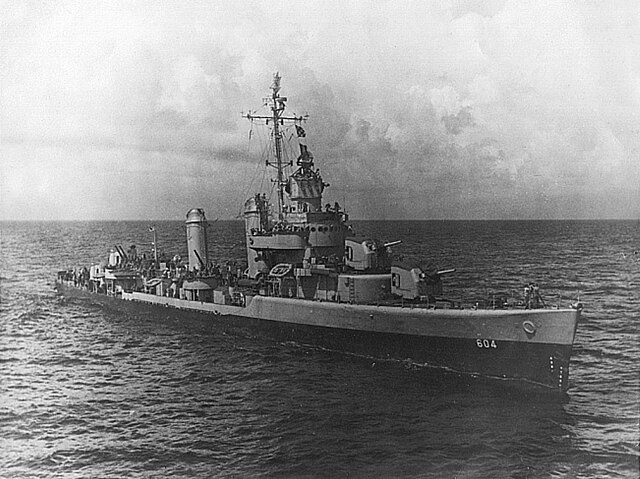
Commissioned on 31 August 1942, after shakedown on the East Coast and off Cuba she started service with a convoy escort to North Africa, and covering landings at Mehedia, Port Lyautey, 7 November 1942. She later five escorted convoys there, and on the it was for Operation Husky on 5–13 July 1943. She escorted other convoys to United Kingdom and Mediterranean and by 6 November she shot several of the 30 attacking axis planes the convoy (she even claimed no less than fifteen).
On 7 February – 2 April 1944 she trained off Maine, and until 11 April served with hunter killer TU 27.6.1. On the 21st she left New York for the Med, Mers-el-Kebir and until 15 May, Naples. She patrolled between Anzio and Naples until 4 June, shelled the Ardea sector on 31 May and 1 June. Until 9 August she was called for the same by the army between Leghorn to Palermo. Next she took part in Operation Dragoon in mid-August. She escorted a convoy from Cap Camarat to Naples and departed on 31 August with DesDiv 16 viz Mers-el-Kebir to New York, arriving on 14 September.
After refit in Charlestown, she transited via Norfolk back to the Med, Naples (26 November) and escorted a convoy to New York. On 6 January 1945 she left with TU 62.1 screening to Oran and later operated off Gibraltar. In March 1945 she supported forces off France and Northern Italy from Cannes and Toulon, bombarding Axis positions on the Ligurian coast. She was back to New York on 23 May and sent to the pacific via Panama, San Diego, Hawaii, to Okinawa, stopping at Eniwetok, Saipan, Tinian, and Guam en route. She started operations on 4 September, escorted a convoy to Korea, Jinsen and back. From Okinawa she was in Tokyo by September 29 and was back in October via Eniwetok, Pearl Harbor (17-22 October) to San Pedro, on the 28th, decommissioned on 31 January 1947, Reserve Fleet Charleston until stricken 1 July 1971, sold 1973. 4 battle stars.
 USS Caldwell DD 605
USS Caldwell DD 605
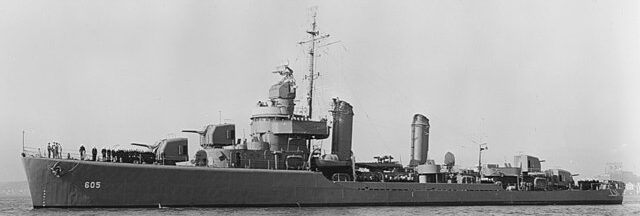
Retaking the name of the lead ship of a famous WWI destroyer class inspiring the Wickes-Clemsons, USS Caldwell was commissioned 10 June 1942 under command of Lt Cdr J. F. Newman, Jr. and on 11 September 1942 she turned to San Francisco to escort a convoy to the Aleutians, staying for the entire 9 months campaign with TG 8.6; She shelled Attu twice and brough direct support for the 17th and 32d Infantry on 11 May 1943 with TG 16.6. She did the same at Kiska on 16 August 1943 and by September 1943, joined TF 15 for planned 18 September air strikes on Tarawa. She joined TF 14, for the attack on Wake. She shelled Peale and Wake Islands, screened aircraft carriers and covered LSTs at Makin, on 21 November and a week of patrols. She was sent to San Francisco in convoy, OVL, and back with TF 52 for the invasion of Kwajalein and Majuro in January 1944. She collided with the carrier USS White Plains and was repaired at Pearl Harbor. She joined TF 58 for the Palau-Yap-Ulithi-Woleai raids and on New Guinea by 22–24 April and the Truk-Satawan-Ponape raids until 1 May). She was back at Pearl Harbor for upkeep.
Sent to Ulithi and Manus with convoys to the Philippines she was near-hit by a kamikaze on 11 December and defended the group, takinga direct hit on the bridge by a kamikaze and fragments from a two bomb near misses, having 33 killed, 40 wounded. Repaired at San Pedro Bay, and then to San Francisco she was back in April 1945 now used as convoy escort, to Tarakan in Borneo, which she shelled on 11–12 May and covered minesweepers off Brunei Bay. On 27 June an influence-type mine exploded close, but there was little deamage, repaired at Victoria, and San Pedro Bay, escorted landing crafts to Okinawa and Leyte until October 1945. She visited Tokyo Bay and went home, decommissioned at Charleston on 24 April 1946. Stricken on 1 May 1965 she was sold on 4 November 1966.
8 battle stars.
 USS Coghlan DD 606
USS Coghlan DD 606

She was commissioned on 10 July 1942 under Lt.Cdr B. F. Tompkins, assigned after shakedown and training to the Pacific Fleet. From San Francisco she departed on 22 September 1942 for Pearl Harbor and started by the Auletian Campaign, Northern Pacific, Kodiak, on 13 October, landings support on Amchitka (12 January 1943), shelling of Gibson Island. On 15 March she clashed off Dutch Harbor with IJN reinforcement south-west of Kiska to Attu. On the 26th she took part in the Komandorski Islands Battle, screening USS Richmond, and covered USS Salt Lake City, hut by a single shell. She later shelled Holtz and Chicago harbors and covered landings on Attu (11 May-2 June). After an OVL in San Francisco she returned to Adak.
On 25 August 1943 she was reassigned for the central Pacific via Pearl Harbor (1 September), covering the raids on Baker and Tarawa (15-17th), Wake (5 October) and back to Pearl Harbor. Next she escorted ships en route for the Gilbert Islands and back in Hawaii on 11 December.
On 22 January 1944 she sailed again screening aircraft carriers covering Marshall landings; On 8 March she ahd an OVL, followed by an escort to Majuro and back. On 24 May this was to Eniwetok, screening landing ships to Saipan on 15 June followed by fire support and patrols until 23 June. She made a respenishment run at Eniwetok and was back to Saipan on 17 July for landings at Tinian on 24 July, and fire support on 1 August and OVL at Pearl Harbor.
Back to Manus on 8 October she started her Philippines Campaign on 6 November 1944, in escort from Palau to Leyte, and cover at Ormoc Bay (7-8 December), driving off kamikaze attacks. 9 January 1945 ssaw her in Lingayen Gulf and she stayed in the area until 8 April, for an OVL at San Pedro, then Pearl Harbor and bacl on 26 August at Okinawa for occupation duty with Japan. On 23 October she was scheduled for home, via Pearl Harbor, San Diego, before arriving like all other ships in her class to Charleston on 2 December for a last overhaul, decomm. reserve by 31 March 1947, stricken on 1 July 1971, sold in 1974. 8 battle stars.
 USS Frazier DD 607
USS Frazier DD 607

Commissioned on 30 July 1942, Fraier made her shakedown training under command of Lieutenant Commander Frank Virden and headed for Noumea with a convoy on 9 December 1942 being used as escort and patrol in the South Pacific for 4 months to Guadalcanal and Espiritu Santo, screening escort carriers. By 18 March 1943 she went to Pearl Harbor to join the task force designated to retake the Aleutian Islands.
She performed the preinvasion bombardment and cover at Attu on 11 May 1943 and patrolled to Kiska. On 12 May she spotted at fired at I-31, making sonar contact and dropping depth charges until bubbles, oil, and debris appeared so she was credited the kill. On 10 June under LtCdr Elliot M. Brown she made more radar contacts or presumed submarines. She is credired the probable kill of I-9.
On 2 and 12 August she shelled Kiska and covered the 15th landings, screening ships ntile recalled for an OVL at Puget Sound.
When returned she headed to Wellington, join transports to invade the Gilbert Islands operation, starting with Efate on 7-13 November 1943, Tarawa, and while off Betio on 22 November she assisted her sister USS Meade attacking I-35, depth-charged and finished off on the surface by gunfore and ramming. She had her bow repaired at Pearl Harbor.
She sailed on 22 January 1944 for the Marshalls, shalling Taroa and Maloelap (30 January), screened USS San Francisco at Kwajalein, then was detached in ASW patrols off Kwajalein and back to Pearl on 15 February. Until 20 March she made another run to the Marshalls, assisted the raids on Palaus, Yap, Ulithi, Woleai.
From Majuro on 6 April 1944 she returned to the fast carrier task group raiding New Guinea on 21-22 April before the Landing at Aitape, Battle of Hollandia. From 10 May to 27 July patrols off Wotje, Jaluit, and Mille (shelled on 26 May) and rescues concluded with another west coast OVL and bacl to Pearl Harbor, Ulithi by 15 December 1944 and the Philippines campaign. From 6 January 1945, in San Pedro Bay she took part in the Lingayen Gulf operation and from 9 January to 26 February performed various missions, notably the shelling of Corregidor on 16 February. This ended in Subic Bay on 10 May. She left San Pedro Bay on 13 May 1945 for Morotai and the Borneo landings, Brunei Bay and Balikpapan. She was back at Subic on 29 July and took part in occupations duties from there and Okinawa to Japan until 3 November. In Charleston she was decommissioned on 15 April 1946, stricken on 1 July 1971, sold for BU 6 October 1972. With 12 battle stars she was one of the most decorated of the class.
 USS Ganzevoort DD 608
USS Ganzevoort DD 608

She was commissioned at San Francisco, 25 August 1942, departing on 18 November 1942 after shakedown and training with a convoy via Hawaii to Nouméa on 9 December. For three months she protected convoys to Guadalcanal from New Caledonia but also the New Hebrides, Wellington and Auckland. On 18 March 1943 she was sent to the Aleutians as par tof the Northern Covering Group to Attu, with the preinvasion bombardment and later spotting and attacking a Japanese submarine on 14 May. Next she shelled and covered landings at Kiska until 12 August.
Departing on 24 August for Puget Sound until 28 September for an OVL, via Hawaii and DesDiv 27 she arrived to Wellington to join RADM Hill’s Southern Attack Force carrying the 2d Marine Division to Tarawa.
After close support on 20 November, she did the same at Apamama Atoll, ravaging the entire Japanese garrison, followed by ASW sweeps until 4 December. However she had developed troubles and was sent via Pearl to San Francisco to have her high pressure turbines replaced.
Departing on 13 March 1944 she arrived for the operations at Majuro on 1 April 1944. She also shelled Mille Atoll until 9 June and Taroa on 8 August and by the 19th replenished in Pearl Harbor before heading for Manus, for her Philippine Campaign.
With DesRon 48 she covered VADM Theodore S. Wilkinson’s Southern Attack Force at Leyte (20–21 October) and until 13 December escorted troopships and supplies from New Guinea. In December this was to Mindoro via Surigao Strait, under heavy attacks. In the Sulu Sea on 28-30 December she underwent 72 hours of constant attacks on the massive convoy. She claimed to shot down 5, assisting 12 and losses were reduced to a single transport and an LST.
She was off Mindoro on 30 December 1944 when a kamikaze hit her main deck to port (34 killed, massive damage). She was powerless. Wilson and Philip assisted to tame her fires and she was towed to the Mindoro PT boats base. Later she was towed to White Beach by FS-367 and effort were made to save her, under numerous attacks and near misses. After a month she was seaworthy enough to proceed on 2 February 1945 to San Pedro Bay, and Ulithi for emergency repairs until 21 April, Pearl Harbor, and San Francisco on 19 May to devaluate battle damage. She departed on 3 October 1945 for New York and Navy Day celebrations. On 1 November she joined the mothballs at Charleston, decommissioned on 1 February 1946, then to Orange, Texas until stricken on 1 July 1971, sunk as a target off Florida, 23 March 1972. 4 battle stars.
 USS Gillespie DD 609
USS Gillespie DD 609

USS Gillespire was commissioned on 18 September 1942 and after shakedown, she left San Francisco on 28 December 1942 to take part in the Aleutian Campaign, arriving in Sand Bay, Great Sitkin Island on 9 January 1943. She took part in her first shelling on 18 February with Indianapolis and Richmond on Attu. This was followed by ASW and anti-shipping patrols, spotting smoke on the horizon at 22:25, the 3100t transport Akagane Maru, fired at and sank from 23:16. The destroyer was back to San Francisco on 4 March for OVL. Via San Diego and Panama Canal she reached New York on 11 April 1943 and made four transatlantic escort missions, notably to Casablanca and North Africa, a reverse of many of her sisters.
On 2 January 1944 from Norfolk she arrived in Funafuti and then to Milne Bay in New Guinea on escort on 7 February. With the 7th Fleet she operated off Saidor and returned to New Guinea, in operations ay Cape Gloucester and Los Negros, notably Hayne Bay on 6 March at the latter, shelling the eastern tip of Pityilu Island on the 14-16th and covering the assault on Manus. She shelled also Rambutyo Islands.
After training until 27 May, she covered the attack on Biak Island and until 2 June 1944, became fighter director/warning picket off Biak. She shelled the latter and Noemfoor Island, Insomeken Point and Arimi Island. More missions were performed between New Guinea and the Solomon, the attack on Peleliu, Palau before departing for an OVL in October 1944 at Bremerton. After exercises at Pearl Harbor and Ulithi she joined the Logistic Support Forces, 5th Fleet for the assault on Iwo Jima.
Until 28 May 1945, she took part in the Campaign of Okinawa and Nansei-Shoto group. On 8 April she was attacked by two Japanese kamikazes, she dhot down both. She was in Ulithi on 31 May, and until 15 Augustn screened other warships off the Japanese home islands. Until 2 September this went on and she was in Tokyo Bay on 10 September. She was back in San Diego on 23 November, Boston on 11 December for an OVL, Charleston, decommissioned on 17 April 1946 in reserve, Texas Group Atlantic Reserve Fleet in Orange, stricken by 1 July 1971, sunk as a target in 1973.
9 battle stars.
 USS Hobby DD 610
USS Hobby DD 610
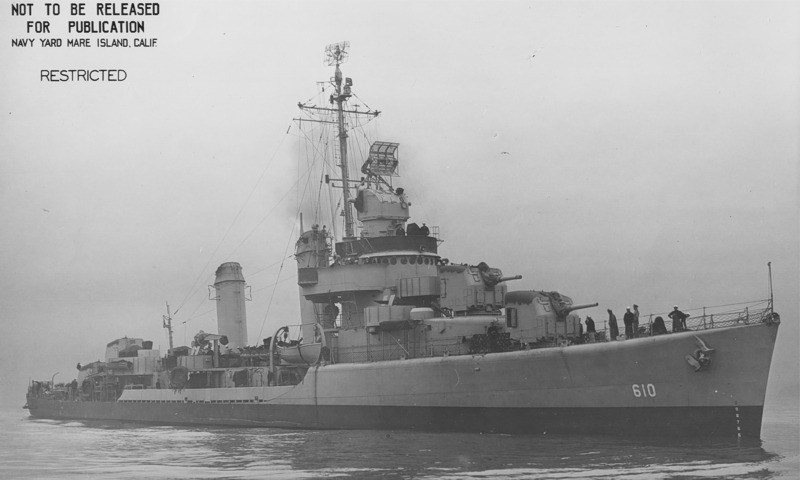
Commissioned on 18 November 1942, under LtCdr Ernest Blake she made her shakedown off the West Coast and started service from New York City on 12 February 1943 in transatlantic convoy to Casablanca. She made five of these, making several U-boat contacts en route, being credited one kill on 9 May. On 2 January 1944 she was ordered to the Pacific, operating in the New Guinea area until 22 August (fire support, ASW escort) notably to the Admiralty and Schouten Islands, then shelling and covered landings at Peleliu and Ngesebus. Her gunners also splashed down several attackers.
On 10 December she joined TF 38 for strikes on Luzon and later Formosa, China coast. By 16 February, she joined Marc Mitscher’s fast carriers, 5th Fleet for raids against Tokyo and other missiones off Iwo Jima and Okinawa. By late June, she was sent to Seattle on 17 July 1945 for overhaul, learning of the Japanese surrender. She was in New York on 6 October for Navy Day ceremonies, carrying foreign naval attaches and congressmen for the Presidential Review before joined the Charleston mothballs on 1 November 1945, decommissioned, reserve, by 1 February 1946, transferred to Orange, Texas in 1947, stricken on 1 July 1971, sunk as target on 1 June 1972. 10 battle stars.
 USS Kalk DD 611
USS Kalk DD 611

Commissioned on 17 October Kalk proceeded to shakedown training off the California coast before being prepared for her first deployment at San Francisco on 28 December to the Aleutian Islands. From Dutch Harbor she arrived at Adak on 9 January, patrolled from Adak and Amchitka and on 16th, recued 185 survivors of the Arthur Middleton and Worden lost on the storm. Pa 26 February for home, arriving San Francisco 4 March.
After repairs, Kalk steamed from San Francisco 7 April and proceeded via the Panama Canal to New York, where she arrived a fortnight later for Atlantic convoy escort duty. She cleared New York 28 April, and the next day joined a 35-ship convoy, UGF-8, headed for Oran, Algeria. Arriving 12 May, she searched for a suspected U-boat. The destroyer departed Casablanca, French Morocco, 19 May escorting a westbound convoy. Arriving New York 31 May, she sailed 13 June via Casco Bay, Maine, and NS Argentia, Newfoundland, to Norfolk for further convoy-escort duty. From 27 June to 6 December she escorted three convoys between the United States and North Africa. After overhaul at New York and Boston, she arrived Norfolk 29 December and then sailed 2 January 1944 for the Pacific.
She sailed on 8 January with DesDiv 38, USS New Jersey and Iowa to Funafuti (Ellice Islands) on 27 January, and operated in the New Guinea area, covered operations at Manus, Pityilu, Los Negros, Rambutye, Tanahmerah Bay, Wakde-Sarmi, Biak, Owi.
She took part in the invasion of Biak on 27 May and at Humboldt Bay. On patrol by 12 June one aicraft in the sun placed a bomb abaft her forward stack close to her starboard torpedo tubes, detonating air flasks of the torpedoes. She had the adjacent 20 mm guns destroyed, the crew injured by shrapnel and her superstructure crippled with 70 casualties. Her fires extinguished, USS Kalk had repairs at Hollandia, and from 20 June sailed to Pearl Harbor and San Francisco on 31 July, Mare Island.
When over she was back on 1 November to Pearl, and by 26 November arrived at Ulithi.
She covered convoys to Luzon and Okinawa protecting the 3rd Fleet and later screened TF 38 at Lingayen Gulf and western Luzon. With DesDiv 38 she joined TG 50.8 on 18 February 1945 for refueling TF 58 for the battle of Iwo Jima. With TG 50.8 she assisted the push to the Ryūkyū and preparations to Okinawa on 1 April. She alternated missions with the 5th and 3rd Fleets. On 5 June with logistic support group TG 30.8 she went through a typhoon with minor damage. On 15 August, she was between Okinawa and Ulithi.
From 20 August she assisted occupation troops to Japan, was in Tokyo Bay on 1 September and back to Eniwetok, then Tokyo Bay again on 16 September, and sailed for home on 12 October via Eniwetok, and Pearl Harbor. San Diego, Panama, Boston on 11 December, OVL, Charleston reserve and decommission on 3 May 1946, then Orange, Texas, stricken by June 1968, sunk as a target by March 1969.
8 battle stars.
 USS Kendrick DD 612
USS Kendrick DD 612
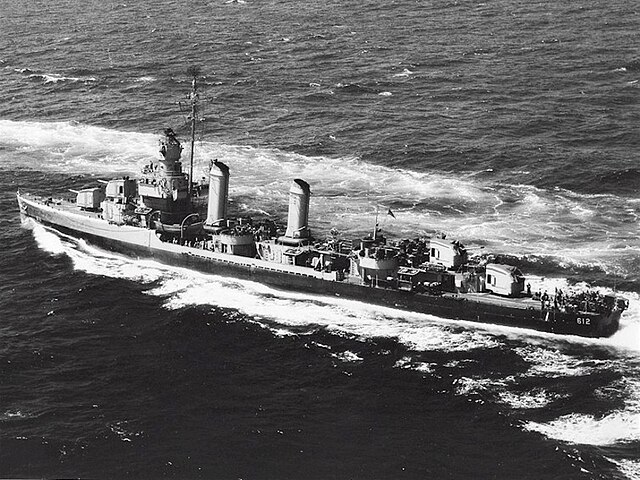
USS Kendrick was commissioned 12 September 1942 and after shakedown exercises along the West Coast she was called for the pacific, San Diego, by 11 December 1942 but returned in Maine on 28 December for ASW exercises. From New York she escorted UG-S-4 on 13 January 1943 to Casablanca for the US follow-up campaign after Operation Torch in November. Back on 13 February she was HP to Norfolk for exercizes, and Newfoundland. She made another convoy run to Oran from New York 28 April-8 June. She returned to the Mediterranean with Task Force 85 (RADM Alan G. Kirk) carrying the 45th Infantry Division. Next she took part in Operation Husky (invasion of Sicily) on 22 June. On 8 July she assisted the Scoglitti landings and guarded transports until 12 July and returned via Oran to New York.
She was back to Oran on 2 September attacked by a Heinkel He 111 on her starboard quarter, arriving 50 feet above the water (so undetected) dropping its two torpedoes before shot down at close range. One struck her stern, destroyed the rudder, fantail, steering compartment, killing one. She managed to reach Oran playing with the shaft differential speed. After summmary repairs in Oran, she was towed to Norfolk on 26 October and after repairs went to UK on 18 February 1944 as convoy escort and was back on Oran on 5 March, patrolled and screened for USS Philadelphia. She provided also artillery support along the Italian coast. From Palermo on 12 August she was sent for Operation Dragoon (RADM Morton Deyo’s American-French bombardment group), supporting the 36th Infantry Division on 15 August. She silenced 88 mm guns batteries, blew ammunition dumps at St. Madrier and went back to Boston, for OVL on 19 September.
She made another convoy run by mid-November and was back to NY on 15 December. She departed Norfolk on 6 January 1945 for the 8th Fleet and for 4 months performed various missiones in the Mediterranean. She left Oran for New York a last time, had an OVL and was sent to the Pacific via Panama, San Diego, arriving at Pearl Harbor on 28 August. After training she was sent to Charleston on 16 October 1945 and remained there until decommission and being sent to Orange for reserve on 31 March 1947, stricken on 1 May 1966, spent in destruction tests at sea by the David Taylor Model Basin. 3 battle stars.
 USS Laub DD 613
USS Laub DD 613
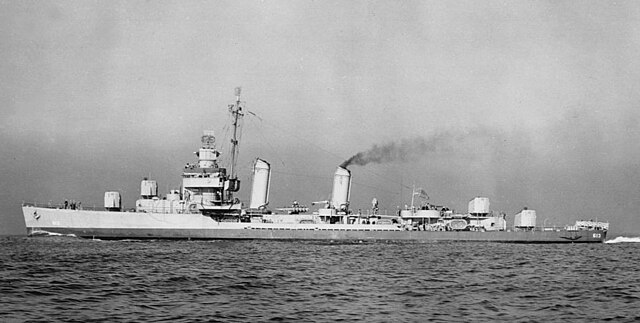
Commissioned on 24 October 1942, after shakedown, west coast, USS Laub was assigned to the Atlantic fleet, crossing Panama to Norfolk on 1 February 1943. From New York on 7 February she escorted a first convoy to North Africa. From Casablanca she patrolled the African coast until 14 March and a convoy back.
She made another run on March. On 26 May, while escorting the return convoy, she chased an enemy U-boat. She made a third convoy run from New York on 11 June and took part in the invasion of Sicily. On 5 July she was there to cover landings on the Sicilian beaches also dealing with Luftwaffe attacks notably on the 11th, as she shelled the shore, downing one. She was credited to destroy four tanks and damaging strategic bridges.
Back to Mers el Kebir Naval based on 15 July she continued operations until back home on 28 July. She made more runs to north Africa and UK and was homeported to Oran for final Mediterranean operations. On 6 November her convoy was attacked underway by six torpedo planes and she assisted the stricken ships Beatty, Maraix, and Ruys, rescued 341 survivors. From November 1943 until April 1944 she made more of these escorts and cross-Atlantic runs between New York and the British Isles for the follow-up operations of D-Day.
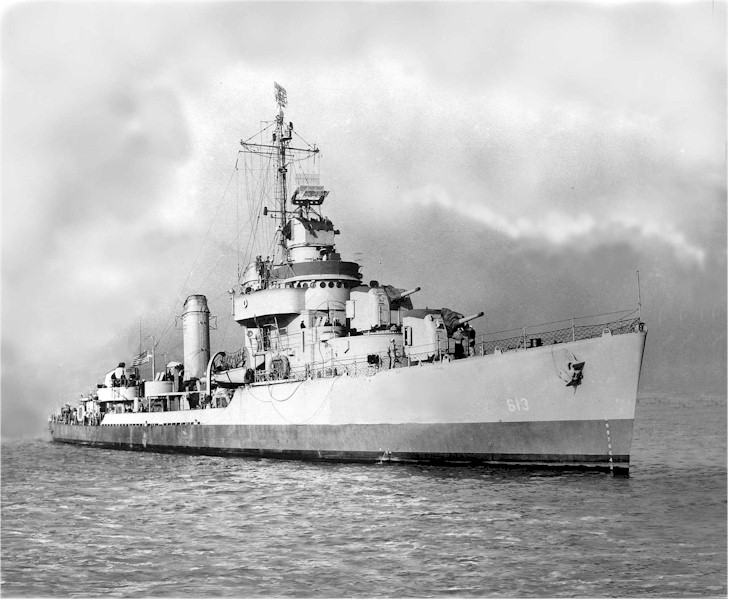
She was in Oran on 2 May screeing USS Philadelphia at Anzio and the west coast of Italy. On the 23rd she collided with the Philadelphia, sent in repairs in Naples and Boston, but back to Oran on 2 December. Next she performed fire support missions off the French-Italian coast, alaways based in Oran. She departed a last time on 15 May 1945 for Boston and trained for the Pacific duty but she learned the surrender as she was in Casco Bay, Maine and se was sent to be decommissioned in Charleston on 2 February 1946, Atlantic Reserve Fleet, stricken on 1 July 1971, sold on 14 January 1975. 4 battle stars.
 USS Mackenzie DD 614
USS Mackenzie DD 614

USS MacKenzie was commissioned on 21 November 1942 and after shakedown training on the west coast, she crossed the Panama Canal on 1 March 1943 to serve with the Atlantic fleet, but like her west coast sisters spent most time in the Mediterranean. She trained in Casco Bay on 13 March, commenced escort missiones in May, for two first transatlantic convoys to the Mediterranean and by 16 May, attacked an U-Boat after sonar contact, postwar analyst will confirm her sinking of U-182.
By late June 1943 she took part in the “Cent” Attack Force of the Sicilian campaign, supported landings at Scoglitti and screened transport vessels, and close fire support. More convoys followed with the Mediterranean until 7 October and then to the United Kingdom. She had a small refit at Swansea, Wales and made two more cross-atlantic runs before reporting to the HP Naples on 18 March 1944 and she took part in the Anzio operation. She sunk a two-man submarine on the 19th and performed numerous gunnery supports and an escort on 6 June. Next she took part in Operation Dragoon, with fire support. On 15 September, she left for Boston and 5-month OVL.
She was back ton the Mediterranean by February 1945 and between 28 March and 21 April shelled Franco-Italian border, blockadeed the Gulf of Genoa. May 1945 was reassignd to convoys to and from Gibraltar. She was back home in July with an overhaul for Pacific service, learning about the Japanese surrender in between. On 4 November she was sent to Charleston for inactivation, decommissioned on 4 February 1946, then reserve fleet Philadelphia, stricken 1 July 1971, sunk as target 1 June 1974. 4 battle stars.
 USS McLanahan DD 615
USS McLanahan DD 615
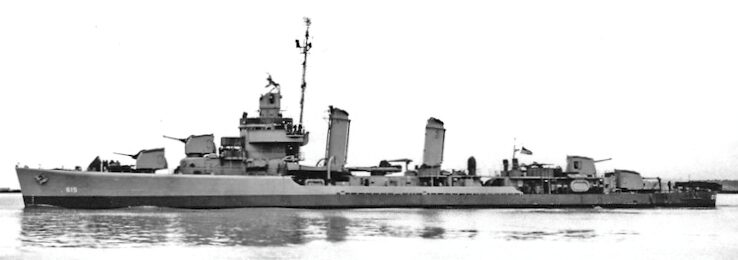
Commissioned 19 December 1942, she trained off the west coast and departed San Diego on 19 February 1943 to be assigned to DesRon 16 in the Atlantic Fleet. From Norfolk on 10 March she trained in Casco Bay and performed coastal convoys, before her first transatlantic convoy to Algeria on 28 April and back on 8 June, then another on the 11th, Oran on 21 June and taking part in Operation Husky. From 6 to 15 July with TF 81 she provided a screen for the invasion forces at Gela. For the next 9 months, her convoys were mostly lossless (only 3). In August 1943, under LTCdr N. C. Johnson she performed another one and on 6 November while underway to Naples from Oran she was attacked by Luftwaffe planes with guided bombs and torpedoes. Two merchantmen were lost and another esscort shups, which she assisted.
On 13 May 1944, another run Oran-Naples for the Anzio operattion was quiet, and she proceded to several close bombardment missiones and patrols along the Italian coast. By late July she was prepaed for Operation Anvil and then off Sicily, starting operations on the 15th near St. Raphael. On the 18th she covered invasion forces, HP Oran and sailed back to New York on 14 September.She was back to the Mediterranean on 21 December. On 19 January 1945 she took part in Ligurian coast bombadment missiones from Monte Carlo to Genoa. Off San Remo on 11 February a heavy short battery round near-hit her port quarter (1 dead, 8 severely wounded) holing her hull above the water line, destroying one gun. She had summary repairs in Oran and in Toulon on 21 March her crew was at an awards ceremony with Croix de Guerre to 12 crewmembers including captain Johnson by French Rear Admiral P. Jaugard. Next she was assigned to Gibraltar convoys and Mediterranean approaches. She cruised in the Tyrrhenian, off north Africa before sailing back home on 30 June 1945 to Boston (8 July) prepared to go the Pacific when hearing about the surrender on 14 August. Instead she made peacetime crews to New York, New Orleans, Louisiana and Guantanamo Bay. She was deactivated at Charleston, decommissioned on 2 February 1946, moved to Philadelphia, stricken on 1 July 1971, BU 1974. 4 battle stars.
 USS Nields DD-616
USS Nields DD-616
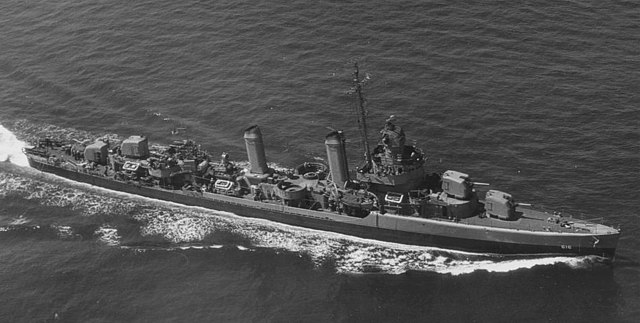
USS Nields was another “late Benson-Gleaves” arriving when the new Fletcher class were there in numbers, and so instead of the Pacific, was assigned to the quieter Atlantic, and built on the East Coast, commissioned ate Boston Navy Yard on 15 January 1943. After shakedown and training she started the same coastal escorts as her sisters in early service: Two tankers to Aruba in Netherlands West Indies as well as Cristobal, Panama Canal Zone. From Norfolk on 11 April 1943, then Boston she was assigned to DesRon 16, HP New York City, transatlantic convoy duty. Her first mission started on 28 April, to North Africa with USG-8, to Oran in Algeria (19 May). This was followed by patrols in late May and later thanks to a British communication she went to the position of a presume position, and managed to detect and sunk the Italian submarine Gorgo (one of 3 sunk by US forces).
She escorted back convoy GUS–7A from 22 May to 8 June. On 26 June she was in Oran and until 5 July performed more ASW off Algeria. On the 5th she took part in the “Cent” attack force, US convoy NCF-1, British convoy KMF-18 for Siciliy, covering herself Transport Area Two until the 13th. From Oran she returned to New York with UGF-9 on 3 August. Small OVK, refresher off Maine. In 1944 she made a serie of Mediterranean and UK convoys (UGF-10, GUF-12, UTF-3, KMF-25-A, TU-03, and TU-6). Commander TF 60 RADM C. F. Bryant commended USS Nields for her rescue operations of Marnix and Santa Helena from convoy KMF-25-A.
In March 1944 she operated with DesDivs 31 and 32 for hunter-killer exercises off Maine. On 7 April USS Champlin and Huse from TG 21.5 sank U-856. USS Nields was commended for her seamanship in heavy seas and low visibility, picking up 11 survivors, landed in NYC to ONI agents for interrogation. She was back to the Mediterranean on 21 April, 8th Fleet for coastal escort and patrol duties from Oran with DesDiv 21. On 2 May she chased a sub for four days. On 14 May she detected U-616 already reported by British aircraft and followed USS Ellyson in the attack, which developed on the 15th. Lost contact, later spotted again surfaced ten miles away by an aircraft. At 1900, 16th USS Nields, Gleaves and Macomb investigated a sound contact and At 21:57 illuminated the sub and opened fire, but U-616 returned fire before diving. At 22:14, 22:31 she was depth charged. At 23:35, 23:42 contact was regained but lost. At 23:46 Nields and 23:50 “creeping attacks” went on and on 17 May, contact was lost and regain again, as the destroyes were now joined by USS Ellyson, Hambleton, Rodman and Emmons, starting their newly learned “box patrol”. After several attack at 06:08, U–616 surfaced, badly damaged and running out of air. She was fired upon and sunk at 06:12, 51 survivors picked up.
USS Nields patrolled along the North African-Italian coast, the Salerno landings, Anzio and Civitaveccia. On 15 August for Operation Dragoon she was off St. Raphael fighting E-boat and performing coastal bombardment at “Red Beach.” She dealt with shore batteries at St. Honorat and St. Marguerite. After more patrols in the area she return to Oran and from there, to the US as screen to Battleship Division 5 on 4 September.
After OVK at Boston, refresher training off Casco Bay, she escorted USS Guam to Norfolk on 27 October 1944 and performed to more north africa, convoys runs with UGS-59 and UGF-19 and stayed with the 8th Fleet on 16 January 1945 and until 9 April for bmbardments of the Ligurian Sea and a MTB attack at Vado and shalling of Bordighera, relieved by her sister USS Kendrick on the 19th and back to Oran and home, New York on 1 May 1945.
She had a new OVL notably for her high pressure steam turbines, trained off Cuba to depart for the Pacific and on 20 July proceeded to Pearl Harbor (9 August). After the 15th she was reassigned to occupation duty, departing on 21 August for Eniwetok, Saipan, escorting USS Lunga Point to Okinawa, and DesDiv 12 at Buckner Bay.
She escorted convoy OKG-7 to the Marianas and returned for the occupation of the Ryukyus with TF 53, protecting LSTs and the 10th Army disarming Japanese positions at Tokara Gunto and Amami Gunto. On 6 October her crew inspected the surviving IJN Hibiki, Amami, and Kunasiri transporting former Japanese POWs to homeland. On the 9th she was caught by a typhoon but was unscaved. She was in Okinawa for tender availability and left the 5th Fleet for home on 31 October 1945 with DesRon 12, San Diego, and then Charleston to be inactivated on 8 December, decommissioned on 25 March 1946, sent to Orange, Texas, stricken on 15 September 1970. Sold, 8 May 1972 for BU. 3 battle stars.
 USS Ordonaux DD-617
USS Ordonaux DD-617

Commissioned 13 February 1943 on the east coast, DD 617 performed shakedown and initial training before being sent to New York and departing on 1 May 1943 for her first convoy to Mers-El-Kebir, Algeria. On 6 July while in Bizerte Naval Base she was attacked by the Luftwaffe, but helped down several.
She took part in the invasion of Sicily on 9 July leading a squadron of MTBs entering the harbor of Porto Empedocle to combat German E boats and Italian MAS boats. She screened allied ships and other invasion operations until the 21st. She made several transatlantic escort runs to the Mediterranean and back.
On 7 April 1944 she took part in an hunter-killer TU, spotting U-856 south of Nova Scotia. Aide with USS Champlin and USS Huse the U-Boat was forced to surfaced, fired upon and rammed by USS Champlin with 28 survivors captured.
On 12 May 1944 USS Ordronaux with USS MacKenzie screened HMS Dido bombarding Terracina and Gaeta, Italian west coast for 5th Army progression on Rome. She went on with Dido and Émile Bertin at the beachhead of Anzio. By 9 August, she was assigned to the fire support force for Operation Anvil. On the 15th she closed to 3,000 yards of the beach to operate surgical fire via liaison officers and Army spotters. She dealt with German 88 mm of shore batteries. Back to convoy duty until 1 May 1945 OVL in New York for alterations, she was assigned to the Pacific. Departing via Panama Canal she was at Pearl Harbor on 24 July, sailed to Wake Island and on 1 August started close fire support. Next she was in Okinawa just before the capitulation and took part in occupation landings at Wakayama and Nagoya. She patrolled off Honshū, and dropped anchor in Tokyo Bay, departing for home, New York, on 31 October.
Assigned to local operations off Charleston she was decommissioned on January 1947, Atlantic Reserve Fleet and later Orange, Texas, stricken on 1 July 1971, scrapped in 1973. 3 battle stars.


 Latest Facebook Entry -
Latest Facebook Entry -  X(Tweeter) Naval Encyclopedia's deck archive
X(Tweeter) Naval Encyclopedia's deck archive Instagram (@navalencyc)
Instagram (@navalencyc)





 French Navy
French Navy Royal Navy
Royal Navy Russian Navy
Russian Navy Armada Espanola
Armada Espanola Austrian Navy
Austrian Navy K.u.K. Kriegsmarine
K.u.K. Kriegsmarine Dansk Marine
Dansk Marine Nautiko Hellenon
Nautiko Hellenon Koninklije Marine 1870
Koninklije Marine 1870 Marinha do Brasil
Marinha do Brasil Osmanlı Donanması
Osmanlı Donanması Marina Do Peru
Marina Do Peru Marinha do Portugal
Marinha do Portugal Regia Marina 1870
Regia Marina 1870 Nihhon Kaigun 1870
Nihhon Kaigun 1870 Preußische Marine 1870
Preußische Marine 1870 Russkiy Flot 1870
Russkiy Flot 1870 Svenska marinen
Svenska marinen Søværnet
Søværnet Union Navy
Union Navy Confederate Navy
Confederate Navy Armada de Argentina
Armada de Argentina Imperial Chinese Navy
Imperial Chinese Navy Marinha do Portugal
Marinha do Portugal Mexico
Mexico Kaiserliche Marine
Kaiserliche Marine 1898 US Navy
1898 US Navy Sovietskiy Flot
Sovietskiy Flot Royal Canadian Navy
Royal Canadian Navy Royal Australian Navy
Royal Australian Navy RNZN Fleet
RNZN Fleet Chinese Navy 1937
Chinese Navy 1937 Kriegsmarine
Kriegsmarine Chilean Navy
Chilean Navy Danish Navy
Danish Navy Finnish Navy
Finnish Navy Hellenic Navy
Hellenic Navy Polish Navy
Polish Navy Romanian Navy
Romanian Navy Turkish Navy
Turkish Navy Royal Yugoslav Navy
Royal Yugoslav Navy Royal Thai Navy
Royal Thai Navy Minor Navies
Minor Navies Albania
Albania Austria
Austria Belgium
Belgium Columbia
Columbia Costa Rica
Costa Rica Cuba
Cuba Czechoslovakia
Czechoslovakia Dominican Republic
Dominican Republic Haiti
Haiti Hungary
Hungary Honduras
Honduras Estonia
Estonia Iceland
Iceland Eire
Eire Equador
Equador Iran
Iran Iraq
Iraq Latvia
Latvia Liberia
Liberia Lithuania
Lithuania Mandchukuo
Mandchukuo Morocco
Morocco Nicaragua
Nicaragua Persia
Persia San Salvador
San Salvador Sarawak
Sarawak Uruguay
Uruguay Venezuela
Venezuela Zanzibar
Zanzibar Warsaw Pact Navies
Warsaw Pact Navies Bulgaria
Bulgaria Hungary
Hungary

 Bundesmarine
Bundesmarine Dutch Navy
Dutch Navy Hellenic Navy
Hellenic Navy Marina Militare
Marina Militare Yugoslav Navy
Yugoslav Navy Chinese Navy
Chinese Navy Indian Navy
Indian Navy Indonesian Navy
Indonesian Navy JMSDF
JMSDF North Korean Navy
North Korean Navy Pakistani Navy
Pakistani Navy Philippines Navy
Philippines Navy ROKN
ROKN Rep. of Singapore Navy
Rep. of Singapore Navy Taiwanese Navy
Taiwanese Navy IDF Navy
IDF Navy Saudi Navy
Saudi Navy Royal New Zealand Navy
Royal New Zealand Navy Egyptian Navy
Egyptian Navy South African Navy
South African Navy






























 Ukrainian Navy
Ukrainian Navy dbodesign
dbodesign
USS Laffey
Laffey opened with gunfire and torpedoes, narrowly miss-collided with IJN Hiei by 20 feet, sent torpedoes and hit her bridge with gunfire wounding Admiral Abe, killing CoS (?meaning?). She spotted another battleship to her port beam, two destroyers on her port bow but had two main battery guns HS (?meaning?)and no torpedo left.
Thks for spotting Jan, it was the XO.